Foreword
THE Ulster Tourist Development Association, Ltd., presents to the traveller in all parts of the world this Guide to Ulster, in the hope that after perusal of its pages he will decide to visit a country noted for its hospitality, and famous for its beauty.
The Tourist Association would like to draw the attention of the traveller, moreover, to the fact that Northern Ireland or Ulster, as it is generally known, is part of Great Britain, and consequently there are no restrictions regarding Customs while travelling in the North of Ireland.
Intending visitors are advised that they can book from almost every large station in England, Scotland and Wales to every large town in the North of Ireland. They are advised to BOOK accommodation in Ulster IN ADVANCE.
Local Guides to the majority of towns mentioned in this Guide may be obtained on application to the Town Clerk or any particular town.
An authentic article on Angling in Ulster Waters may be obtained, free of charge, on application to The Ulster Tourist Development Association,
A Brochure containing pictures of Ulster Scenery may be obtained for 1/- at the Association's Offices, or from the principal Stationers in Belfast.
Correspondence should be addressed to the Organising Secretary, The Ulster Tourist Development Association, Ltd., 6 Royal Av., Belfast, Ulster.
Co. Antrim.
Antrim
The town of Antrim, on the main road from Belfast to Portrush and Londonderry, is one of the most popular inland resorts in Northern Ireland. Picturesque itself, it is seated in charming country. densely wooded. within a stone's throw of the rippling waters of Lough Neagh.
"On Lough Neagh's banks when the fisherman strays
In the clear cool eve declining,
He sees the round towers of other days
In the waves beneath him shining,"
But Antrim has no need to appeal to legend for one of the only two perfect round towers in Ulster stands within its ambit. At one end of its High Street, the principal thoroughfare, is the Parish Church. The lofty spire, from which curfew is rung at nine o'clock every evening, was built in 1812. The Six Mile River flows at the back of High Street, and is spanned by the Massereene Bridge, which one must cross to reach Lough Neagh from the town. This river and its tributaries can be fished for trout. Permits to fish the river Maine can be obtained from Lord O'Neill.
The Lough is about a quarter of a mile from the town, and is reached by a beautiful winding road, bounded on either side by Lord Massereene's estate and bordered with pretty plantations. The ruins of Antrim Castle can be seen from the road, and across the shining waters of the lake one sees old Shane's Castle, the ancient home of the O'Neill's, the renowned chiefs of Ulster in bye-gone days.
North of the town in the private grounds of Major G.F.C. Clarke, stands the Round Tower already mentioned, 95 feet high. These towers are believed to have been built about the 9th or 10th century as places of refuge. Four miles east of Antrim is a curious humpbacked hill, called Donegore Moat, a settlement and burial place of primitive man, from which it is said five counties can be seen, and in the old graveyard close by, Sir Samuel Ferguson, a well-known Ulster poet (1810-1886), is buried.
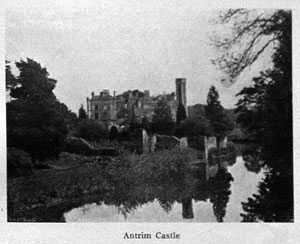
Aldergrove Aerodrome, an important R.A.F. centre, is four miles distant; and at the pretty village of Muckamore, which might be described as a suburb of Antrim, are the country works of the York Street Flax Spinning Co., Ltd., Belfast, which is the largest linen firm in the world. In Antrim itself there is a prosperous weaving factory.
The cottage in which was born Rev. Alexander Irving, D.D., author of that poignant Irish peasant life story, "My Lady of the Chimney Corner," and other works, who by his own efforts, rose from a newspaper boy, is in Pogue's Entry, off Church Street, where a memorial has been erected to his parents.
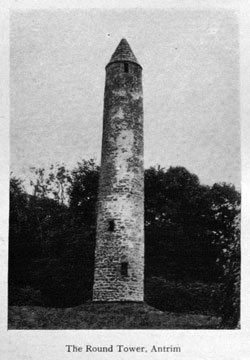
The Massereene Golf Club has a pretty nine-hole course along the shores of the Lough -- green fees, 2/- per day. There are tennis clubs at Antrim and Muckamore, both open to visitors. Cruises in large motor boats are run on the lake to Ram's Island, Shane's Castle and other places, whilst rowing boats can also be hired from local fishermen.
Close to Antrim lies Dunadry, the rendezvous of the insurgents in the rebellion of 1798, in a district well stocked with trout streams.
Ballycastle.
691/2 miles from Belfast, is a pleasant seaside town in the famous Glens district. It has an extensive strand, bathing-places, golf links, and a specially fine scenes of tennis courts.
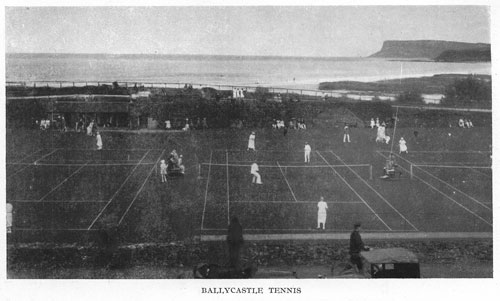
Behind the town towers the great mass of Knocklayd, a rounded hill, 1,695 feet in height. In front is a beautiful bay curving away on the right to the majestic promontory of Fair Head. Across the Bay, about five miles distant, is the cliff-walled island of Rathlin, to which R Bruce fled from Scotland in 1306. Here he is said to have watched a persevering spider, and to have learnt therefrom the lesson which resulted in "Bannockburn."
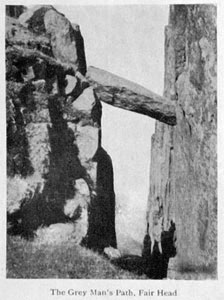
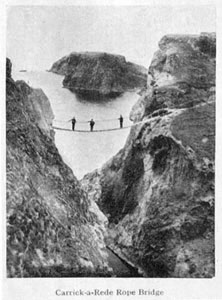
Ballycastle is a convenient point from which to visit the north-east corner of Antrim and to see Fair Head and Ballintoy and Carrick-a-Rede, where a crazy-looking rope bridge hangs over a chasm between two high walls of rock, and Murlough Bay, a place of "unspeakable grandeur and beauty." "This is a rarely-visited corner of County Antrim. That fact will make it additionally attractive to those who dislike over-populated places. But the traveller need not be afraid that he will have difficulty in getting to it. The railway or bus will take him to Ballycastle, and the rest of the journey may easily be accomplished from there by road. He will, if he desires to indulge his sense of beauty, make an effort to get to Ballintoy and Murlough Bay."
Other interesting places near at hand are The Grey Man's Path, Kinbane Castle. Dunineny Castle, and the ruins of Bonamargy Abbey, and the Round Tower at Armoy, beautifully situated on the River Bush, which is a good fishing river for both trout and salmon.
For those interested in the history and legends of the country, there could be no better stopping-place than Ballycastle. Two of the most beautiful of old Irish tales are associated with the neighbour-hood, for on the shore are the rocks known as Carrig-Usneach, where landed Deirdre and the children of Usneach coming to betrayal and death and this sea is the Moyle of the story of the children of Lir --
"Silent, oh Moyle, be the roar of thy waters,
Break not, ye breezes, your chain of repose,
While, murmuring mournfully, Lir' s lonely daughter
Tells to the night-star her tale of woes."
Further information as to hotels, boarding-houses, etc., may be obtained on application to the Town Clerk, Ballycastle, County Antrim.
Ballyclare,
Is a flourishing inland town, 10 miles from Belfast. Extensive bleach works, paper mills and spinning factories make for the prosperity of the town, which has close association with Belfast, owing to extensive railway and bus connections. A bauxite mine in the vicinity has increased its trade, as large quantities of that mineral are shipped via Larne.
Ballymena.
The "City of the Seven Towers," is the natural geographical centre of County Antrim; situated almost midway between Belfast and Portrush.
Railway lines run to Portrush, to Larne, and to Parkmore (for Cushendall); and there is a large number of bus services.
In and around the town are many memorials of the past. These include several raths, known locally as moats, which appear to have been at one time fortified dwelling-places commanding the valley which they surround. Probably the most perfect of these is Dunfane Moat, about a mile to the north of the town, which looks down over the valley of the Braid.
A sporting nine-hole golf course is situated on the old Broughshane race-course, within two miles of the town, and it is well patronised. There is also a good nine-hole course at Craigdun Park, Hillmount, Cullybackey, where there are extensive bleach works.
The Lawn Tennis Club, housed in the People's Park, has three courts. At one end of the same park is the bowling green, which is one of the most popular resorts in the summer months.
The Ballymena Cricket Club has its well-laid-out and carefully-kept grounds in the Castle Demesne.
The rivers in the vicinity of the town abound in trout, and, to some extent, salmon, and excellent sport is obtained along the Braid River, Kells Water, Clough Water, and the Rivers Maine and Bann. Kilrea is famous all over the kingdom as a fishing centre.
GRACEHILL, a Moravian settlement about two miles from Ballymena, was founded in 1765, and is a secluded peaceful spot enclosed by buildings on the four sides of a square, with the Church in the centre of one side.
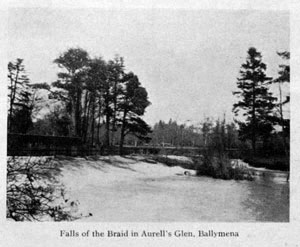
SLEMISH, "the only true mountain in the country," where St. Patrick herded, is eight miles to the east of Ballymena, via Broughshane. Near Broughshane, and about five miles from Ballymena, is the ancestral home of Field-Marshal Sir George White, V.C., the hero of Ladysmith, and a memorial to him is to be seen in the Broughshane churchyard.
Other places worthy of a visit include KELLS, which contains the remains of an abbey; Templemoyle; TOOME, famous for its eel fisheries; and RANDALSTOWN, beside which is Cranfield Holy Well, a centre of pilgrimage.
Amongst famous men whom Ballymena district can claim are Sir William Brown, who was Chairman of the Atlantic Telegraph Company, of which Lord KelvIn was engineer, Ulster thus having a double share in the greatest achievement of modern times, the laying of the Atlantic cable and Timothy Eaton, who founded the great Toronto firm which bears his name.
Ballymoney
Is an agricultural market town. A narrow gauge railway runs from Ballymoney to Ballycastle, on the North Antrim Coast. Two townlands -- Enagh and Cross -- preserve the ancient name of Aenach-Cross, the "fair of the crosses," suggesting that this may once have been the scene of pagan games and festivals. Two at least of Ballymoney's bye-gone inhabitants are worth remembering -- Admiral John M'Bride, a very gallant sailor, of the Nelson period, and his brother, David, a physician much in advance of his time, whose remedy for scurvy Captain Cook, the great explorer, tried with complete success.
Belfast
The capital of Northern Ireland, is, as a town little more than three centuries old.
History notices it at rare intervals. Edward Bruce, about 1315, destroyed the fortress. William de Burgo, Earl of Ulster, was assassinated here in 1333; after that and until the reign of Elizabeth it was mainly in Irish hands. It was in the reign of James I, that a Devon man, Sir Arthur Chichester, Lord Deputy of Ireland, received a grant of this territory; and under his fostering care the little town took root and prospered, receiving a charter of incorporation in 1613, with the right of returning two members to Parliament.
The geographical situation was favourable. Though not until late in history did it become the present magnificent harbour. It was always the natural mouth of the import and export trade of the North-East; and as Scotland and the North of England developed with the coming of the age of steam, Belfast shared in their growing activities.
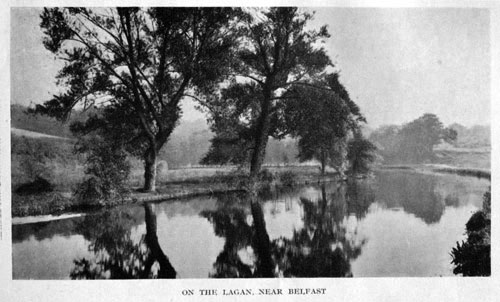
While the woollen and other trades of Ireland were repressed the cultivation of flax and the manufacture of linen were founded and encouraged in the North, and Belfast became the centre of what is yet its principal industry.
The enterprise of a young shipbuilder, Edward Harland, founder of the great firm of Harland & Wolff, put on the coping stone, for Belfast then had the great desideratum for prosperity -- employment for both sexes. It has for 20 years held the blue ribbon for Shipbuilding.
In 1757 the population was 8.549; in 1851, 100,301. Forty years later it had more than doubled; and at the census of 1926 it was 415,151, with a valuation of £1,802,824. It does not possess the advantages of a native supply of coal and iron; but, despite this, its products in shipbuilding, linen, rope and all the term connotes, tobacco, whiskey, and aerated waters are famous all over the world.
Belfast, as has been said, is the chief port in Northern Ireland, having steamship services with Ardrossan, Glasgow, Heysham and Liverpool. and (via Larne) to Stranraer. So that it is a natural point of arrival for all who visit the North for either business or pleasure. It is served by three railway companies, and a daily-increasing complexity of buses, there being no part of the province that the visitor cannot reach with ease and speed.
Seated amid an amphitheatre of lofty hills, and approached by a water-way whose beautiful shores converge upon it, Belfast owes much to Mother Nature. Few towns can in so few minutes offer such ready access to beauty as Belfast, as few countries can yield such a variety of beauty as the North in general.
Belfast is the seat of the Government of Northern Ireland, of a Cathedral, and of a University. Sometimes thought of as merely a city of shopkeepers, it was the birthplace of Lord Kelvin, of Sir William MacCormac, and Sir Almroth Wright. To go back to the 18th century it was the birthplace of Dr. William Drennan, in whose poems the description of Ireland as the "Emerald Isle" first found birth . To return to the 19th century it was also the birthplace of Sir Samuel Ferguson, a poet of real distinction. Of our own generation Mr. Forrest Reid is a novelist with a very subtle and sensitive genius, and Mr. Richard Rowley's poetry, beautiful in itself, has carried beauty into the grime and stress of workaday life. Mr. R Lynd, a truly delightful essayist, is a Belfastman, as is Mr. Douglas, editor of the "Sunday Express." Mr. St. John Ervine, the famous author, dramatist and dramatic critic, and Mr. George A. Birmingham, are also Belfast born. The world of art is enriched by the works of Mr. William Conor, Sir John Lavery, and Mr. George Morrow, of "Punch." To the stage Belfast has contributed Mr. J.B. Fagan, author of the happy "And so to Bed," Mr. John Rea, of "Abraham Lincoln" fame; and three clever women -- Miss Cathleen Nesbit, Miss Moyna MacGill, and Miss Helen Gilliland. Both Lord Bryce and Sir Donald Currie were natives of the town.
In a city so (comparatively) young the visitor need expect no relics of antiquity, but close to the town is the famous Giant's Ring, which can be easily reached by car. St. Anne's Cathedral is steadily rising to the fulness of its dignity, the Municipal College of Technology impresses by its very mass, as does the Queen's University by its grace. The City Hall is ornately handsome. and contains stately halls of Creek and Italian marbles, and suites of rooms approached by marble staircases. This Hall boasts of many attractive memorial windows, but the one of which Belfast is most justly proud is that which commemorates the deeds of her sons on the battlefield in the great war, and which bears a tablet containing the tribute of King George V. -- "Throughout the long years of struggle, which have now so gloriously ended, the men of Ulster have proved how nobly they fight and die." A Museum, the foundation stone of which was laid by H.R.H. The Duke of York on 22nd July, 1924, is at present being erected in the Botanic Gardens. The first section will cost over £80,000.
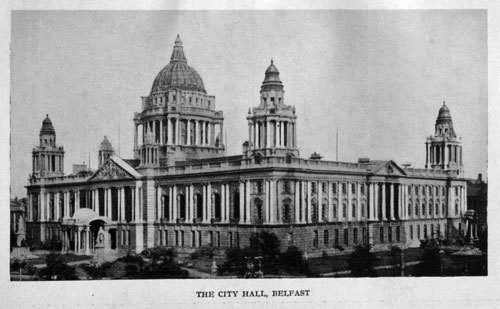
In the matter of Public Parks, Belfast caters well for the citizens. From the beautiful grounds at Bellevue Gardens, or Hazelwood, where there is a good cafe, a splendid view of the Lough can be obtained; the Botanic Gardens, with its unique fernery and spacious conservatories; the Ormeau Park, of 100 acres, with its facilities for cricket, croquet, tennis, golf, boating, football, and other pastimes; the Alexandra Park, with its well-arranged flower beds, and several other minor Parks, all attract the visitor by their beautiful scenery.
Further information regarding Hotels and Boarding Houses in Belfast can be obtained from The Ulster Tourist Development Association, Belfast. Ulster. "The Belfast Book," price 2/6, may be obtained from the Town Clerk, City Hall, Belfast.

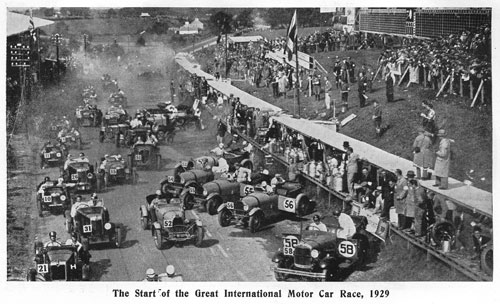
Bushmills
A neat little town on the River Bush. The river is well supplied with salmon and trout, and affords good sport to anglers. The town has acquired a more than local reputation by its production of whiskey known to connoisseurs as "Old Bushmills."
In the midst of an extensive plantation lies Dundarave House, the seat of Sir Francis MacNaghten, Bart.
Carnlough
Is a quiet, yet popular watering place built round a beautiful bay similar to the Bay of Naples.
Behind it rise the terraced slopes of the mountains, and a few miles to the north on a plateau laid bare by a gigantic landslide is Garron Tower, once the home of the Londonderry family, but now a palatial hotel with carved frescoes in the interior and beautiful gardens surrounding it. Not far away are the remains of the great fort of Dungallon. according to tradition the last fort in Ireland to be held by the Danes. Carnlough has several good hotels and boarding-houses.
Within easy walking distance are many beautiful waterfalls, and a curiously formed cave in the heart of which, some 50 or 60 feet under the limestone cliffs, a wall has been found constructed undoubtedly by human hands.
Tennis, boating, fishing and shooting are all available in the neighbourhood. and as there are no currents in the bay, it is an ideal place for children's bathing. The stretch of golden sand helps to complete a perfect picture.
Carrickfergus
The ancient town of Carrickfergus has a great deal to interest and attract the tourist.
As a holiday resort it is quiet and restful, with excellent bathing and boating facilities.
The main road passing through it from Belfast merges a few miles farther on into the world-famous County Antrim Coast Road, with its unrivalled panorama of magnificent scenery. But apart from its central and convenient situation as a starting point for viewing the beauties of the Counties of Antrim and Down, Carrickfergus has in itself much to offer the visitor, especially from an historical and archaeological point of view. It is the only place in County Antrim where there are remains of ancient mural defences, and where there is a Castle in occupation which was built before the English connection. From a scenic standpoint the situation of the town on the shores of Belfast Lough is exceedingly beautiful.
The antiquity of the town is demonstrated to the visitor by the appearance of the old gate known as the North Gate. This Gate reminds one of the fact that Carrickfergus was formerly a walled and fortified city. It is the last remaining of four gates which gave entrance through the walls -- the West Gate, the Quay Gate, the Water Gate and the North Gate.

The principal entrance to the old Parish Church of St. Nicholas is from Market Place, and a few words must be devoted to this most interesting building, which possesses many features of unique interest to the student of ecclesiastical architecture. It is supposed to occupy the site of a pagan temple, and was originally connected with a Franciscan Monastery founded about 1232. The Church is believed to date, part from the 11th century, part from the 12th, and part from the 13th century. It contains many interesting relics and inscriptions, but its most remarkable monument is undoubtedly the stately erection which occupies the wall of the north aisle. In this aisle was formerly the burial place of the Chichester family, and the Monument there is to the memory of Sir Arthur Chichester and his wife and infant child.
Carrickfergus Castle is indisolubly linked with the history of the town. In the palmy days of Carrickfergus, it was the strategic importance of the Castle as a military fortress that led to the long line of memorable events associated with the town's history. The Castle still remains as the one clearly outstanding archaeological feature of the place that has suffered least by the lapse of centuries of time, and its historical associations and its striking position and perfect state of preservation, combine to render it one of the most notable relics of the Norman period to be found in the whole kingdom. The probability is that it stands on the site of an old Irish stronghold, such as was common prior to the advent of the mediaeval castle-builders. The site was well chosen. The great mass of rock on which it finds its foundation is formed by one of those protrusions of molten lava, through a fissure in the earth's crust, which geologists name a dyke, and which are common along the adjacent shore, standing out as serrated ridges above the ordinary level of the tenacious red-salt bearing clays of the neighbourhood. While the Castle has undergone many alterations in its time, in the main it continues to present all the features it possessed in the 12th and 13th centuries. On three sides it was accessible to the tide. The keep is 90 feet in height, and its walls fully 9 feet in thickness. Originally it was divided into five stories. A spiral staircase leads to the summit, from which a magnificent view of the Antrim and Down shores and of the town and district is to he had. The solitary approach on the North, or town side, takes the place of a mediaeval drawbridge.
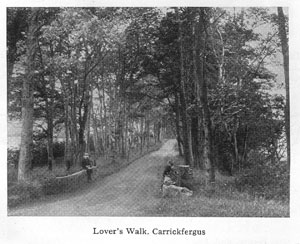
The barbican towers that flank the massive entrance have an imposing appearance. Inside the arch-way is an overhead slit, through which molten lead or other missiles, which might be considered suitable, could be poured on the would-be invader; and the old portcullis, with its suggestive and inimical-looking teeth, still remains within the outer gate. The upper room in the Eastern tower gives architectural evidence of former use as a chapel.
The Golf Course, which is nine holes, is situated at North Road, within three minutes' walk of the centre of the town. There is a fine Club-house, and visitors will always meet with a hearty welcome. The fees are very moderate.
Public Lawn Tennis Courts have been provided in the new Park at Belfast Road at reasonable rates. In this Park, and also the Shaftesbury Park, games and amusements are provided.
Facilities for bathing, boating and fishing are abundant, and the town is well served with football and hockey clubs.
There are delightful walks in and around this historic old town, and lovely motor drives, embracing all classes of scenery. The roads in the neighbourhood are well kept and good for motoring.
Further information regarding Hotels and Boarding-houses may be obtained from the Town Clerk, Carrickfergus.
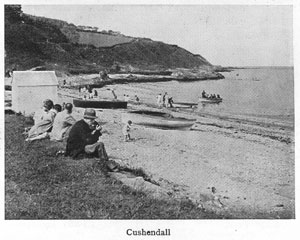
Cushendall
May be reached either by the "second finest coast road in the world," or by the railway from Parkmore, whence there is a delightful drive through the famous Glens of Antrim. Cushendall is a pleasant sheltered village lying at the foot of Lurigethan on a charming bay. Historically it is associated with the story of the great soldier-poet Ossian, whose "grave," with its stone pillar circle, stands on a shoulder of the mountain at Lubitavish, while the antiquarian finds abundant interest in Layde Church, souterrains, and other relics of the past. There is good trout fishing in Glenariff, Glendun, and Cushendall rivers, and good hotels and boarding-houses may be obtained in the towns. Cushendall is an ideal resort from which to visit the far-famed Glens of Antrim.
Cushendun
A word meaning "foot of the brown river," is a beautiful village situated on a magnificent bay. Nature is here seen at her wildest -- Glendun, Torr, Murlough and Cushleake stand close at hand, while behind the two good hotels are the famous Cushendun caves.
Here was the home of Moira O'Neill, whose "Songs of the Glens of Antrim" are sung the wide world o'er; and here, too, the burying place of Shane O'Neill, whose name must ever be linked with Irish history.

Giant's Causeway
Mr. St. John Ervine, the famous author, in his book, "Ulster," describes the Causeway thus:-- "The wide world has heard of the Giant's Causeway which has some natural connection, according to geologists, and some fantastic connection, according to those who put their trust in legends, with Staffa in Scotland. Accounts in prose of such a place as the Giant's Causeway must always be unsatisfactory, and, perhaps it will be better for those who have never seen the Causeway that they should look at a single picture of it than that they should read reams of gusty words about it. This place is a miracle in stone. One looks at the polygonal stones -- they vary from stones of three to stones of nine sides -- and has difficulty in believing that they were not carved by masons, and set down in that regular array by a giant's labourers. Though why the vanity of man should make him imagine that Nature is less likely to have skill in these matters than himself is hard to understand.
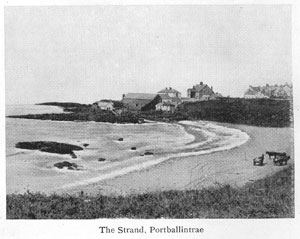
"In some wild or romantic effort of her imagination, Nature flung these stones fantastically together, and then, with a careless gesture, allowed the sea to flow over and submerge most of them. If the traveller desires to live near the Causeway, so that he may devote his mind to it, there is good accommodation for him both at the Causeway and the adjacent village of Portballintrae, a quiet, pretty spot near the old distillery town of Bushmills."
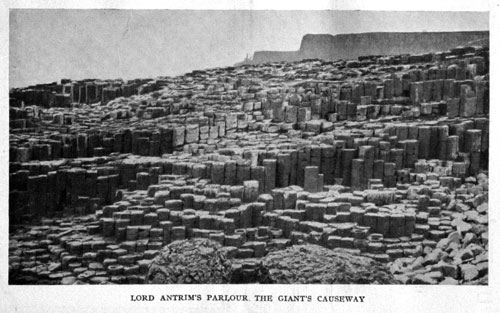
The Causeway lies eight miles from the famous seaside resort Portrush, which is connected wIth it by the first Hydro-Electric Tramway in the world, which was opened in 1883 by Mr. Wm. A. Traill, C.E.
It is difficult in "cold guide-book language" to do justice to this far-famed and wonderful spot, or to describe "the huge black headlands drooping down to the sea in strange columnar leaps," the galleries, the colonnades, and the black irregular rocks streaked with seams of crimson iron ore, and covered here and there with verdure of all hues and qualities. It must all be seen to be realised.
There are three Causeways -- the Little, the Middle (or Honeycomb), and the Grand Causeway, the last-named being the chief attraction.
At first some are disappointed. It is comparatively small, and not of great extent, but its perfect honeycomb masses of basaltic columns are most interesting and curious. Guides point out that of its 40,000 columns there is only one of three sides and three of nine sides, and that most are pentagonal and hexagonal.
Accounts in prose of such a place as this must always be unsatisfactory, and no description can give an adequate picture of what has been truly described as "a miracle in stone." But the words of such a writer as Dr. De Witte Talmage will convey some of its atmosphere -- "One of the strangest places on earth. The rocks are cut as by mathematical calculation. A man is a fool who can look at these rocks and not realise that the world had a design and a Designer."
"Before you die you must see the Giant's Causeway. You go to look at a celebrated lake, but you have seen other lakes. You go to look at a high mountain, but you have seen other mountains. You go to see a great city, but you have seen other cities. But there is nothing in the world like the Giant's Causeway."
"Ireland might well have been built if for nothing but to present the Giant's Causeway. It lifts us to the sublimities. It will be the last pillar of earth to crumble."
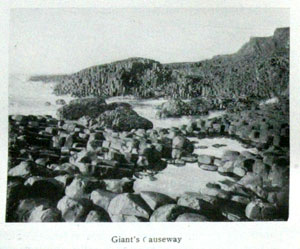
The visitor usually leaves the Grand Causeway by "The Giant's Loom," and goes on to the "Organ" by a path which the Causeway Syndicate has provided for the public, to bring within their reach some of the finest bays and greatest wonders of the place. The path is nearly three miles long, and leads round by "the Chimneys," two separate pillars standing some forty-five feet in the air, one of them shortened by a stray cannon-ball from the last ship of the Spanish Armada, which mistook them for the chimneys of Dunluce Castle, and round by the succeeding headlands. This walk takes two and a half hours.
The visitor who wishes to enter into the wonders and interests of the place should allow himself half a day at least. The walk along the top of the cliffs ought not to be missed. "It is impossible," says Mrs. S. C. Hall, "for painter to portray or the imagination to conceive, a walk of more sublime beauty than that along the headlands from the Causeway to the Pleaskin."
A visit to the magnificent caves of Runkerry and Portcoon, by boat, ought not to be omitted from the programme: but visitors should not take this trip without experienced boatmen.
-----------------------------------------
Following are the Authorised Charges Payable to Guides.
Short Course (Giant's Causeway, organ and amphitheatre) . . . 3/-
Long Course (including above and Land cave) . . . 4/-
Visitors to make their own terms for hire of boats.
Visitors are particularly requested not to pay fees to any but authorised Guides wearing badges, and to report to Mr. C.R.C. Leech, Secretary, any cases of incivility or attempts to overcharge.
-----------------------------------------
Glenariff Glens
Immediately after he leaves Larne, the traveller arrives at the Coast Road, close to the sea. and under the shadow of high and lovely hills. The road itself is smoother for motoring than either the Grand Corniche or the Corniche d'Or. It has an uncommonly fine surface, and is almost free from blind corners and sudden twists. The driver can see far ahead of him, and is under no compulsion to keep his hand on his brake because emergency is always to be expected. Running along this road, "the second best in the world," according to the late Lord Northcliffe, the traveller sees, on clear days, the coast of Scotland, twenty miles away. The limestone hills glisten whitely under their dark basaltic heads. and when the whins are in bloom yellow blossoms are like stars in a cloud-flecked sky. In some places along the road the hills rise steeply up in such a shape that they seem to be columned like a cathedral, and they have an austere grandeur that makes them appear to be higher than they are. Soon we come to Glenariff.
"Glenariff has a remarkable variety of cascades and waterfalls tumbling from its sides to the river. Some of them are threads of water; some spread themselves out, so that they look like a girl's white veil; and others pitch and toss and rattle down in a sort of fury, as if they could not quickly enough get to the sea. Here among the many falls are Ess-na-Larach, 'the fall of the battle-field,' and Ess-na-Cruib, 'the fall of the hoof,' and the very beautiful 'Tears of the Mountain,' which drops over a broken rock like long tassels of white hair."

This Glen may be approached by bus or by rail from Belfast to Larne, thence by bus, or from Ballymena to Parkmore, and the visitor should take the trouble to look out for Slemish Mountain where St. Patrick was a shepherd before he went saving the souls of heathen Scots, or decided to return to Ireland and convert the Irish. The Terminus of the railway is at Parkmore, a tiny station on the edge of a bog, and a most solitary place.

"One's heart begins to fail, as one surveys the terrible sterility of the bog, and then suddenly -- for it happens suddenly -- the Glen opens, and Nature, which a moment before had seemed to be lean and spare and desolate and full of doom becomes prodigal with beauty and casts he; loveliness about, generous and without care. The road bends and one sees the Irish Sea, as blue as the Mediterranean or, sometimes, like jade. The road descends through trees and past torrents, with here a fall at one's feet, and there a cascade blowing out from a hill-top, like white smoke, until at last, as the Glen widens and shows its farms, it drops down to the level of the sea where Waterfoot stands at Red Bay. There are nine glens in Antrim, and each one of them is lovely, but Glenariff is the queen of them all."
Glenarm
On the famous Coast Road, 12 miles from Larne, Glenarm stands at the entrance to one of the beautiful valleys of Antrim, Glenarm Castle, the home of the Earl of Antrim, stands at the bottom of one of the streets. It occupies a commanding position, has a fine deer park, pretty waterfall, salmon leap and charming walks. There is a fine new golf course, open to visitors, in the town.
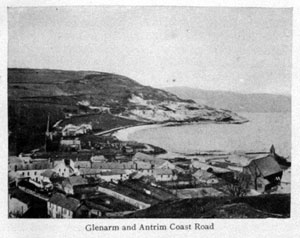
"Outside Glenarm great lumps of basalt lie across a footpath, one piece seeming to be so perilously perched on another that a puff of breath might blow it over. This is called 'The Madman's Window.' Could any name be more apt? Only some demented Samson could have conceived and executed the idea of this window made of huge rocks."
Glenavy
A charming village one and a half mile from Lough Neagh and fourteen miles from Belfast. The Glenavy River is a favourite resort for anglers, and the district is rich In historical places of interest.
Islandmagee and the Gobbins.
Islandmagee
The peninsula called Islandmagee commences near Whitehead Station.
The northern portion of the "Island" is a few minutes by ferry-boat from Larne. At the Druid's Cottage, which is about half-a-mile from the ferry, there stands a group of massive stones, known as the Druid's Altar. Gold ornaments are said to have been found in the neighbourhood of this cromlech.
On the shore near Brown's Bay stands a "rocking stone," one of the many evidences found in this district of what geologists term the "glacial epoch." It is an ice-borne block, and is said to weigh from 10 to 12 tons.
The Gobbins
The bold cliffs known as The Gobbins lie off the eastern shore of Islandmagee, about three miles from Ballycarry station. They can be conveniently reached from the station by the public road which leads to the top of the Gobbins Brae, or by the Gobbins Path, which commences about a mile from the station.
The Gobbins consist of great precipices of basaltic rocks extending along the shore for about a mile and a quarter, and rising sheer from the sea to a height of 240 feet. The rocks are the home of great flocks of sea-birds, and are penetrated by numerous caves, one of which has yielded a fragment of an antler of the red deer and a miscellaneous collection of bones. Up till the year 1902 an adequate view of The Gobbins could only be obtained from the sea but in that year a cliff path, constructed by the engineer of the Belfast and Northern Counties Railway, rendered them accessible to pedestrians. The pathway runs near the base of the cliff, and, in some places, is cut out of the almost perpendicular face of the rocks. The Man-o'-War Sea Stack, a conical-shaped rock, surrounded by water, has been connected with the mainland cliff path on one side by a remarkable open-work tubular bridge, oval in section, and constructed of steel; and on the other side by a shorter ordinary steel girder bridge, The view from these bridges is very striking.
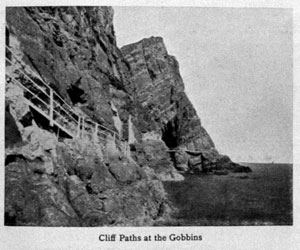
Larne
A favourite watering-place in a salubrious situation, occupies a most charming position on the East Coast of Antrim, there it cosily nestles in the bosom of the verdant hills by which it is almost surrounded. In the summer season many thousands of visitors are attracted to it as a health tourist centre and charming holiday resort. For many, years it has been the "Home of the Tourist" while visiting the sylvan retreats, the lovely glens, and the charming scenery of the Antrim Coast, fitly described as "the boldest and most fascinating coast scenery an Ireland."
Larne Harbour is well known as the point of arrival and departure of the Larne and Stranraer Mail Steamers, which convey passengers from port to port in less than two hours, including only 70 minutes of open sea. Such admirable facilities are provided at Larne by either coach, rail, or sea trips, that tourists can easily and inexpensively visit almost any place of interest along a vast tract of most charming Irish scenery, and return to Larne the same evening.
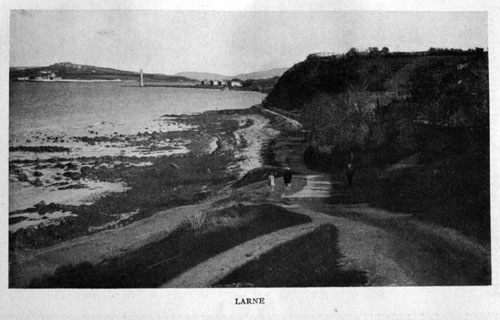
Of the many objects of interest of which Larne is the centre, the most popular and attractive outing is a drive on the famous Antrim Coast Road, running north of Larne for a distance of over 50 miles of the grandest scenery Ireland can produce. One writer observes -- "Had the engineer worked with a poet and painter at his back he could not have lain out his course more agreeably to the eye and imagination. Cliffs cut through, chasms crossed, water courses bridged, a roughly ribbed and jagged coast traversed by a road as smooth and almost as level as a tennis court."
The Bank Heads, at which the bathing-places are found, form a natural amphitheatre commanding the Channel, and constitute the favourite resort alike for townspeople and visitors.
Boating, bathing, bowling, tennis and fishing can all be indulged in here to the heart's content while on Islandmagee, close by, are picturesque golf links, which afford ample scope for every club. New links are now available in the town itself.
The ruins of Olderfleet Castle, at the Corran (which signifies "a reaping hook"), have a most interesting historical record, and denote the place where Edward Bruce, the last Monarch of Ireland, landed in 1315 with his band of Scots, when he attempted to free Ireland from English rule.
Further information regarding Hotels and Boarding-houses may be obtained from the Town Clerk, Larne.
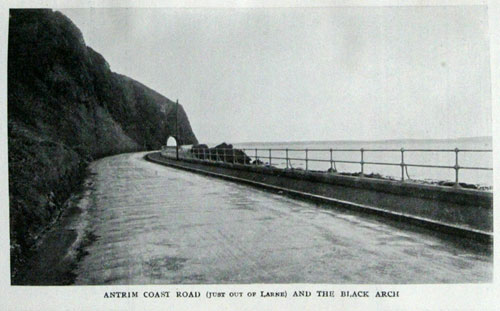
Glenoe Village and Waterfalls. This village, five miles out, is considered. by many the quaintest hamlet in County Antrim, lending itself to the photographer's art in a way that no other place does.
Driving or walking to Glenoe by the Belfast Road you pass through the
Village Of Glynn, a favourite spot for the artist, abounding, as, it does in rural beauty -- pretty cottages. winding streams, and picturesque ruins. Here may be seen the ruins of an ancient church, said to have been founded by Saint Patrick. In the same direction is
Magheramorne, a district celebrated as being the birthplace of St. Comgall, who was founder of Bangor, in the year 517. It is now famous for its quarries of limestone. In the same direction is
Ballycarry, where Islandmagee joins the mainland. In this village the first Presbyterian Church established in Ireland was erected in 1611. At Red Hall, close to the village, is the old Mill Glen, one of the loveliest spots in the neighbourhood of Larne. Also the ruins of Castle Chichester and Kilroot, rendered famous by the residence of Dean Swift.
Carncastle, is a short run from the road at Ballygally Castle, and for variety the return journey may be made by the old inland undulating road to Lame.

The Sallagh Braes, have a peculiar interest for tourists who are fond of mountain climbing. They are easily reached at a distance of three miles from Larne, and extend for two miles in a northern direction facing the sea with a safe path all the way, and the visitor feels like walking along the ridge-tiles of a huge roof of some mighty cathedral of nature. At the northern end is Knock Dhu, a rounded bluff, 1,262 feet above the sea, affording a magnificent view of the Irish Channel, the Scotch hIlls, and Ailsa Craig, and a vast stretch of mountain scenery from Agnew's Hill to Slieve-nae-Nee and Trostan, near Cushendall.
Lisburn
On the River Lagan, seven miles south of Belfast, is principally noted for the extensive works which it contains -- flax spinning, the manufacture of linen and thread, bleaching and damask weaving, all being extensively carried on.
The Technical School, Castle Street, which was opened in 1914, was formerly the residence of the late Sir R. Wallace, Bt., and is built on the same plan as Hertford House, London, where the famous Wallace Collection is housed.
The Castle Gardens, presented to the town by Sir J. Murray Scott, are kept in excellent order as a public promenade, and in the grounds there is a handsome monument erected, by public subscription, as a Memorial to the late Sir Richard Wallace. To perpetuate the memory of Brigadier General John NIcholson, the hero of Delhi, a Lisburn man, although born in Dublin, a bronze statue (presented by the late Henry Musgrave, D.L., Belfast), is erected in Market Square. A popular resort is Wallace Park, containing 27 acres.
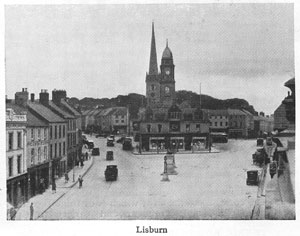
The Cathedral of Christ Church is a spacious and handsome building, and was opened for Divine Service in 1623, during James I reign, when it was known as the Church of St. Thomas, then Christ Church in 1662, and it was during the reign of Charles II, that it was raised to the dignity of a Cathedral for the Diocese of Down and Connor. In the burying-ground at the Cathedral lie the remains of many famous men, including Louis Crommelin, the Huguenot founder of the linen industry in Ireland.
The famous Jeremy Taylor held a lectureship in Lisburn, and later was appointed Bishop of Down and Connor. Bishop Taylor resided at Magheraleave, Lisburn, in a house which can still be seen. Lisburn may well be proud of her associations with the author of "Holy Living," "Holy Dying," and "The Great Exemplar:'
Lisburn is fortunate to possess the most efficient rail and bus service in Ireland -- trains running to and from the Northern Capital at 15-minute intervals throughout the day, and the bus service at 10-minute Intervals.
There is a splendid 9-hole golf course within five minutes' walk from centre of town and Railway Station. There are fine cricket, tennis and bowling grounds in the Wallace Park, and also hard tennis courts and bowling greens at the Hilden Recreation Grounds.
The terms for visitors to the golf course are at the rate of 2/- per day for the first five days of the week, and 3/- on Saturdays, Bank and Public Holidays. No Sunday play.
The rivers Lagan and Ravarnette are two of the best trout-fishing rivers open to all comers in the Province, and for lake fishing Ballykeel-Lougherne, situate about four miles from Lisburn, contains some huge trout. This lake is situate on one of the leading bus routes.
Portrush
To many the name recalls the happiest days of childhood-to some the choicest experience of a lifetime -- to all who have ever been there it brings a whiff of the freshest, purest, most exhilarating air on earth and a vision of glorious ocean sunsets.
The town of Portrush is about seventy miles from Belfast, the capital of Northern Ireland, from which it may be reached by either train or bus. By rail you travel through a beautiful country in one of the London Midland and Scottish Railway Co.'s splendid trains, and after about ninety minutes of pleasant travelling you suddenly find a bold coastline opening to view, and finally you run into Portrush itself.
The town, with its rich yellow sands, its coastline of beetling cliffs, its contiguity to the romantic Giant's Causeway, its splendid hotel and private residential accommodation, its classic golf links, and its cosmopolitan society, stands in a class by itself. Portrush has been called the Brighton of Ireland, but only on the ground of its social and popular charm, for when had shingly Brighton golden sands, romantic cliffs, and a world's wonder at its threshold?

Portrush is built on a Promontory which runs out about three-quarters of a mile into the Atlantic; this gives it the advantage of three sea fronts.
It is a place of far greater antiquity than those who see it in its modern and up-to-date condition can easily believe. It was first called "Port-rosse" in 1262, at which time it had a church and a castle. The church and the castle and the thatched houses are all gone, and we have in their stead the Portrush of to-day, with the natural advantages and the ancient beauties which will ever form Its chief attraction, but with fine streets, handsome terraces, churches for many denominations, large business houses in which all needs are anticipated, numerous high-class hotels and cafes with dance floors, lodging and boarding-houses, where accommodation to suit all classes and purses may be found.
As a health resort, Portrush is practically unrivalled. "The air is just intoxicating. It is not so keen as one might expect from the northerly situation, but silky, soft, and yet without a suspicion of heaviness." It is singularly efficacious in driving away distempers of mind and body, and is specially recommended to sufferers from insomnia and nervous diseases.
Ramore Head is a magnificent headland to the North-west of the town. running out into the sea, with steep. dangerous cliffs. on the West flat top. and beautiful green slope to the East, covered with softest grass be-jewelled with thousands of tiny flowers in their season.
The air on the top is unrivalled. The view almost so, covering, as it does, an expanse from West to East of eighty miles. To the West we see Downhill and the silver streak of Lough Foyle, with the blue mountains and headlands of Donegal in the distance, and the island of Inistrahull, with its revolving lighthouse, a never-failing object of interest; whilst to the North lie Islay and Jura; to the East the Mull of Cantyre. Rathlin Island, and the Causeway Cliffs. The glory of a sunset viewed from the top of Ramore Head on a fine June evening is not easily forgotten.
A long range of islands lie close by, of which the principal are the large and the small Skerry, the "Winkle Isle," and the "Castle Isle." An afternoon tea party by boat to these islands is a very favourite excursion.
A walk along either the East or West Strands is a health-giving pleasure. The West Strand is about a mile long, and ends at the Black Rocks. The East Strand, commonly known as "the White Strand," is about two miles long, and leads to the White Rocks.
The White Rocks are limestone cliffs which the unwearying sea has worried into numerous fantastic shapes, such as "The Lion's Paw," "The Giant's Head," and "The Wishing Arch." There are 27 caves, the greater number accessible only by boat.
In contrast to these charms of Nature at rest is the scene at the foot of Ramore hill on the land-ward side where the Recreation Grounds extend. These have been constructed at great expense by the Urban Council, and include bowling greens, tennis courts. putting greens, etc. The bowling greens, two in number, were laid by experts from Scotland with sods of Cumberland turf. the best in the world for bowls. There are ten grass tennis courts, and four hard courts, constructed of the renowned En-Tout-Cas material, playable under any atmospheric conditions. The putting green contains eighteen holes difficult enough to test the skill of the best golfer. Play on these recreation grounds goes on from morning to night, and the people of Portrush are as proud of the Grounds as the visitors are pleased with them. Rackets, balls, overshoes. clubs, etc., may be hired at reasonable rates from the officials in charge by those who have omitted to bring such things with them, and there is a pavilion in the Grounds where refreshments of al kinds may be obtained. Tournaments and matches are constantly being arranged, and every effort made by the Sports Manager to please and interest patrons.
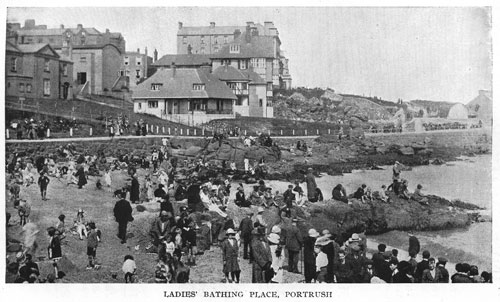
The Royal Portrush Golf Links are famous, and may justly be described as the St. Andrews of Ireland. There are two courses of eighteen holes each, one being for ladies. The men's course is nearly four miles round, and gives scope to golfers of all degrees and talent. Many a golfing champion has been reared on these links, and few golfers of renown have not played on them. The London "Times" said of Portrush Links -- "It is a jolly place with very jolly golf, and it has that indefinable innate quality of rearing golf champions unending."
For the man who delights in fishing there are ample opportunities for indulging his taste. He may either fish from the rocks, or hire a boat and try his luck in the bay. A permit can be obtained at the Town Clerk's Office for a small fee to fish for trout in the Waterworks, about a mile from the town. Within easy reach are the rivers Bann and Bush, both noted for salmon.
It is at once apparent that Portrush is ideally situated for bathing. On both east and west sides there is deep water, where those who delight in swimming and diving can enjoy themselves to the full. The Blue Pool and South Pier are known to bathers the world over. For those who cannot swim there are equally good facilities; the Ladies' Bathing Place on the east side being particularly suitable. At all of these places boxes for undressing are provided, and attendants always present to help and advise. It is possible, too, to undress indoors and slIp wrap-covered to the water.
These things are for the active -- and even when on holiday the majority of people like to be on the move.But for those who want a real lazy time Portrush in summer is an ideal spot.There are the long stretches of clean sand with their borders of grass-covered dunes where the visitor may lie at this ease, and innumerable little nooks and corners made more comfortable by restful seats all along the sea front. There are two fine grassy stretches at Lansdowne and Craigvara where one may recline and watch the fun -- and there is plenty of that in summer time.Nor must the attractions of the perrots be omitted and the wonderful variety of amusements at the pitch at the Lansdowne Green. Here are hobby-horses, swingboats, char-a-planes, hoop-la stalls, etc., etc., catering for all tastes and all ages. Portrush is also well supplied with picture houses and concert halls.
Antiquaries find interest in the old churches of Ballywillan and Dunluce, and Gig-ma-Gog's grave near Beardiville.
To geologists the famous Portrush "Rock," below Lansdowne Crescent, with its innumerable ammonite impressions, is of deep interest.
The season is at its height during July and August. During those eight weeks it is crowded with visitors, and enlivened by excursion parties and excursion bands. The large amount of sunshine and the long clear evenings make June a favourite month, and the mild weather in September and October make them ideal months for golf.
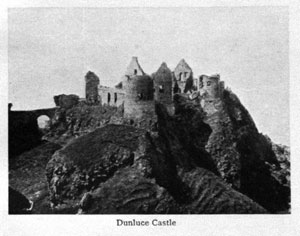
DUNLUCE CASTLE (3 miles from Portrush) calls for attention, because of its historic and scenic interest. This remarkable ruin is easily reached by tram or car. The road runs above the White Rocks, and the traveller on his way thither looks down not only on fantastic shapes, but also on the most wonderfully coloured sea it is possible to imagine -- greens and blues, pinks and browns, all intermingled in beautiful and indescribable colour effects. He also drives over "Long Gilbert," the cave where the limestone is quarried, called after Gilbert M'Laughlin, otherwise known as "Lord Antrim's fool," a man seven feet high, who never wore shoes, and who could run as fast as a horse.
Running one day with the hounds near this spot, he was unable to stop himself in time, fell over the cliff, and was dashed to pieces.
"The Priest's Hole" is also passed -- a fearful-looking cavity into which a priest is said to have jumped when trying to escape from his pursuers.
The Castle of Dunluce -- one of the most picturesque ruins in Ireland -- dates from the fourteenth century, when it was re-built on an old site by Richard de Burgo. It stands upon, and completely covers, a bold black headland, over a hundred feet high, and jutting out into the sea. It is connected with the mainland by the top of an old drawbridge wall, on the other side of which are grey towers, winding stairs, a great roofless, ruined kitchen, bare to the cliff's edge, but still containing its massive hearth and chimney. The Castle was sometimes held by the M'Quillans, sometimes by the MacDonnells, till, towards the end of the sixteenth century, when, through a mixture of war and matrimony it finally passed to the MacDonnells, who have held it ever since.
Portrush and the Giant's Causeway are naturally associated. but the Causeway has already been described.
BUSHMILLS, a neat little town on the River Bush, lies close to Portrush. Famous for its whiskey. It is also well known to anglers as a favourite resort for salmon and trout.
Further information regarding Hotels and Boarding-houses may be obtained from the Town Clerk, Portrush.

Whitehead
The interests of Whitehead lie in the manifold attractions of town, country and sea, combining to make an ideal place in which to spend a holiday.
This popular seaside resort is charmingly situated on the north shore of Belfast Lough, on the famous Antrim Coast Road, 15 miles from Belfast and 9 from Larne.
A fine Esplanade and pathway leading to Blackhead, with its caves and cliff path, afford a beautiful promenade facing the sea, from which a good view of Belfast Lough, the County Down Coast, Copeland Islands and Lighthouse can be obtained; and on clear days a considerable portion of the Scotch Coast is plainly visible across the Channel.
There is a very fine nine-hole Golf Course, and visitors on payment of 12/6 may enjoy a week's golf, or may pay 2/- for a day's play; competitions open to visitors are held during the season.
There is also a Tennis Club with two hard courts, on which visitors may play on payment of a small fee.
The Club House of the County Antrim Yacht Club is situated at the south end of the Esplanade, and great interest is taken in the weekly sailing events and Annual Regatta. Motor boat trips may be taken on the Lough, and sailing and rowing boats hired.
Sea bathing is liberally indulged in, and Ladies' and Gentlemen's Bathing-Places will be found near the Esplanade.
Fishing from boats and also from the rocks at Blackhead may be had by those who enjoy this form of sport.
Further information regarding Hotels and Boarding-houses may be obtained from the Town Clerk, Whitehead.
Co Armagh
Armagh
Situated on the sloping sides of several gently ascending hills, and adorned with many public edifices built in various styles of architecture, is undoubtedly a beautiful inland town. The River Callan flows in its vicinity, and in several parts of its meandering course approaches within a few hundred yards of the city.
The name "Armagh" means the height or hill of Maha. This was the name of a queen who reigned over Ulster, and probably all Ireland, about the year 300B.C. She built the palace of Eamhain Maha (pronounced "Avan Macha"), the mounds and encroachments of which can still be seen outside the city. These remains are known locally as the Navan Ring or Navan Fort, and it is interesting to note that the situation of this fortress, which was probably a political capital, is only a short distance from what became, and is to-day, the ecclesiastical capital of Ireland.
An old-world city, filled to overflowing with so many recollections and visible evidences of a history extending back for a period of over 2,000 years, can scarcely fail to posses its own distinctive charm. Almost at every turn the visitor is confronted with some tangible reminder of the city's hoary past.The Navan Ring recalls the dim pre-historic period of the Red Branch Knights -- 300 years before the birth of Christ. The old Cathedral stands on the site of the original church built by St. Patrick in 445. Within its grounds King Brian Boru has lain since the Battle of Clontarf in 1014. On the banks of the Callan, hardly a mile from the town, repose the remains of King Niall III., who was drowned in the river at that spot in 846. And this, in turn, recalls the fact that Armagh was then occupied by the Danes. The battlefield of the Yellow Ford summons up memories of the gallant Red Hugh O'Neill, of Marshal Bagenal, his valiant opponent, and personal enemy, and of the "Virgin Queen" Elizabeth, whose troops were so completely routed there in 1598. Various public buildings, such as the Observatory, Library, etc., erected during the more settled period of the eighteenth century, are lasting memorials of the desire felt by the Primates Robinson and Beresford to add to the knowledge and well-being of their people. And, finally, we have the New Cathedral, whose twin spires pierce the sky from one of the city's highest hills. Erected during the nineteenth century by national subscription it stands first "Cum Gloire De agus Onora na h 'Eireann" (to the Glory of God and the Honour of Ireland), and next as a memorial to the National Apostle, Saint Patrick, from his Irish Catholic followers all over the world.
In the Cathedral are many old military and volunteer colours, amongst them being the only French colours ever captured by a militia regiment.
The Observatory was founded in the year 1791 by Richard Robinson Baron Rokeby, Protestant Archbishop of Armagh. Observations of great value have been made and recorded continuously since 1791 right down to the present day. The chief work standing to the credit of the Observatory is well known as the "Armagh Star Catalogue." It is in everyday use among astronomers all over the world.
Visitors will be courteously received and shown over the Observatory, if some little notice be given previously to the present astronomer in charge Rev. W. F. A. Ellison.
St. Patrick's Well is situated in a field beside the old coach road near the old Callan Bridge. There is an informal pilgrimage to the Well once a year, on the eve of the feast of SS. Peter and Paul -- 29th June. Local tradition has it that on this night at 12 0 'clock the Well overflows.
The Druid's Ring is about a quarter of a mile from the Navan Fort. The circle of huge stones and central altar are, however almost completely buried by the soil.

Around Armagh is a famous fruit-growing district and on the shores of Lough Neagh, close at hand, lies the little town of Maghery, with two good hotels. From Maghery, Coney Island, about a mile out, can be vIsited. In Armagh Itself are situated the links of the Armagh Golf Club, where visitors are cordially welcomed, while, for the fishermen, there is an abundance of trout and free fishing in the Callan.
Among the famous things associated with the Primatial City is the "Book of Armagh," an exquisitely illuminated manuscript, containing a life of St. Patrick, and a copy of the New Testament, written A.D. 807.
Armagh has a famous school, "The Royal," which has had as students many distinguished men.
Close to Armagh lie Loughgall, a great fruit centre, and Markethill, which contains the demesne of the Earl of Gosford, and a castle built in the Norman style with granite from the Mullaglass Quarries. Within the demesne is a place known as Drapier's Hill, which was the favourite resort of Dean Swift during his visits there in 1729.
Bessbrook
A small town situated in a beautiful and well-watered valley convenient to the Camlough mountains. There is an electric tramway from Newry, three miles distant. The scenery is very beautiful. The towelling, diapers, damasks, etc., made at Bessbrook are known the wide world over.
Camlough
Within less than an hour's motor run from Rostrevor or Warrenpoint and less than half an hour from Newry (in which a run round the model town of, Bessbrook, with its magnificent linen mills, might be included), lies due west the village of Camlough, the entrance to the highlands of Slieve Gullion (1,893 feet), and Camlough (1,385) between which lies the lovely sheet of water, Camlough Lake (the crooked lake), which supplies the town of Newry with an abundant supply of water, and furnIshes a bit of surprising semi-Alpine scenery not to be equalled perhaps in the whole North of Ireland.
Lurgan
The town of Lurgan, situated in the north of the County of Armagh, 20 miles from Belfast, and on the direct railway line between Belfast and Dublin, is one of the chief centres of the linen industry.
Brownlow House, for many years the Irish residence of the Lords of Lurgan, is a fine castle standing a short distance from the centre of the town. Attached to the castle were 350 acres of well-planted demesne, 90 of which now form the PublIc Park, and contain an artificial lake of an extent of 53 acres.
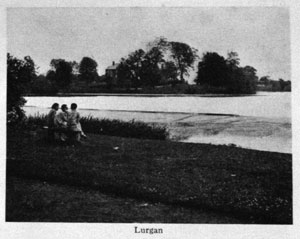
Lough Neagh, the largest fresh-water lake in the British Isles, is about a mile from the town, and provides a pleasant rendezvous for tourists and picnic parties. On the shores of the Lough, on a spot named Oxford Island, there stand the ruins of Killwillick Church, used in 1641 as a garrison by the troops of Sir Phelim O'Neill, and afterwards burned by them.
The Lough is abundant in "Pollen," a fresh water herring, shipped to England in great quantities by fishermen who reside in the vicinity. There is also abundant duck and widgeon shooting to be had, and in summer ample facilities are available for boating and yachting.
The manufacture of linen in all its branches was first introduced into Lurgan by William Waring (an M.P. for Hillsborough), and was the means of stimulating the rapid growth of the town, which in 1619 contained 42 houses. A Linen Hall for the sale of webs was built by subscription on the space now occupied by Church Place, and the growth of this market was so rapid, that in 1825 the weekly sales averaged a turn-over of from £2,500 to £3,000. The first power-loom weaving factory was built in 1855, and now the town possesses six power-loom weaving factories, upwards of twenty-five handkerchief factories, as well as handkerchief printing and boxmaking factories.
In the matter of sports, there are two golf clubs (both within the town), and open to visitors at 2/- and 1/- per day, respectively, tennis courts, bowling greens, and cricket pitches, all of which are also open to visitors.
Americans should be interested in the fact that in this town was born, on the 20th October, 1674, James Logan, statesman and scientist, secretary to William Penn.
A few miles from Armagh, in the town of Markethill, stands the demesne of Earl of Gosford. There are several Danish forts within the demesne which was a favourite resort of Dean Swift.
Further towards the Co. Down coast, close to Poyntzpass, are portions of the Great Wall of Ulidia, or Ulster, a most remarkable erection, which can be traced from Lisnagade, north of Scarva, to near Jonesborough.
Portadown
On the River Bann, is a manufacturing and market town, with a population of 12,000.
No provincial town in Ulster is more easy of access. About 26 miles from Belfast (Capital of Northern Ireland), and 84 miles from Dublin (Capital of the Irish Free State), it is the principal railway junction on the Great Northern Railway, the lines from Belfast to Dublin, Londonderry, Armagh, Cavan, and the midlands of Ireland, running through the town. Being situated on the fringe of the "Fruit garden of Ireland" -- the Richhill, Loughgall, and Annaghmore districts -- and having among its industries nine large linen weaving factories, three handkerchief factories, three flour mills, two foundries, two bacon-curing factories, a furniture factory, a spinning mill, a cider factory, and several other minor industrial concerns, the natural products and manufactures find their way to the ends of the earth.

The Bann basin, and the mosses and bogs within easy reach of the town, offer an extensive field of play to the sportsman at all seasons of the year. The Public-Park, covering an area of about 30 acres, is tastefully laid out wIth walks, extensively planted with evergreens and trees of various sizes and varieties, and is divided by a tributary of the Bann. A new Pleasure Carden has recently been constructed in the centre of the town, where a bowling green is about to be laid out. Facilities for amusements and healthy recreation include racing and rowing boats, fishing, golf links, football grounds, tennis courts, a Carnegie Free Library, and numerous reading and recreation rooms.

Its hotels and restaurants are ample and commodious.
"Disponendo me non mutando me" is its motto, which may be translated -- "You can shake me, but you can't knock me down." What was called by the historian Froude, "The Peace of Portadown," was signed in September, 1795, three days before the Battle of the Diamond between the Protestants and the Defenders. The Diamond is a townland situated about 4 1/2 miles from Portadown in the direction of Loughgall, and in the centre of the "Fruit Garden."
A short distance from Portadown, between that town and Lurgan, was born the distinguished "A.E." -- G. W. Russell -- a poet, a painter, an economist, and an exceedingly fine journalist.
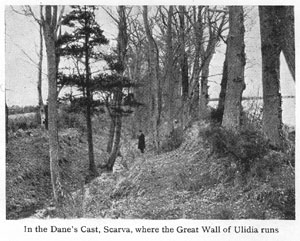
Another famous native of the neighbourhood of Portadown was Sir R Hart. Inspector General of Customs in China, where he was the most influential and most upright European the East has ever known. He was born at Portadown, son of Henry Hart, Ravarnette House, Lisburn. and Ann Edgar, G.C.M.G., member of a score of orders, Ancestral Rank of the First Class of the First Order for Three Generations, Sir R added more lustre to each of them than all could add to R Hart.
Scarva
One of the most picturesque spots in Ireland, is on the main line of the Great Northern Railway. On the borders of the village is a fine old demesne, open to visitors, in which is annually fought the historic battle known as the Scarva Sham Fight. Scarva is noted for the purity of its water and its salubrious air, and is a favourite resort for those seeking health, as well as tourists and anglers. The Great Wall of Ulidia runs through Scarva.
Co. Down
Ardglass
("The Green Height"), is famous lor Ardglass, its herring fishery, over two hundred boats being engaged in the summer fishing, and in the proper season fish-vendors may be heard in the streets of Belfast crying -- "Ardglass hearns!" There is a high common in this village, called the Downs, on which is an excellent and sporting links, and from which the Isle of Man can be seen. Here also is one of the stoutest and oldest of the famous County Down's strongholds, Castle Shane, carefully conserved. The coast can be followed from Ardglass up to Strangford Lough and round the southern shores of that inland sea to Downpatrick.

Overlooking the sea half a mile to the north-east of Ardglass stands the ruined church of Ardtole, which is interesting as showing the characteristic Anglo-Irish parish church of the Middle Ages.
King's Castle, overlooking the town, is the magnificent "Holiday Home" of the Belfast Co-Operative Society, and members of co-operative societies throughout Great Britain can obtain full particulars of charges on application to the Manageress, King's Castle, Ardglass, or the Co-Operative Society, Belfast.
Ballynahinch
"In the middle of Down is Ballynahinch, where there is a fashionable spa. It has two springs -- one chalybeate and the other sulphurous. Five miles from Ballynahinch is Slieve Croob('the mountain of the hoof'), a bare and gaunt mountain in which the River Lagan rises. There were five great cairns on top of Slieve Croob. Two and a half miles from it, in the townland of Legananny, is a remarkable cromlech standing on a slope to the west of Boley Lough. Down is full of cromlechs and circles and ruined churches; it is the cradle of Irish Christianity, but it retains many traces of 'the ould, ancient days' of paganism."
One of the loveliest views in the whole of the lovely County Down is obtainable from Killinchy-in-the-Woods, as the road rises from the water and you look back to the islands in Strangford Lough.
The Spa has an excellent golf links.
A few miles away in the village of Ballygowan the women do exquisite hand-embroidery, and the village has long been renowned for its blue stone quarries used for "sett-making." On the other side of Ballynahinch, among the hills and close to the foot of part of the Mourne Mountains, lie Dromara, and Slieve Croob, where the River Lagan rises. This part of the Lagan is well known to anglers for its trout. Close by is Begney Lake where large pike have been caught, while in the mountains, close at hand, there is plenty of shooting -- grouse, partridge, duck and snipe abound.
Banbridge
The tourist who desires to see a typical Ulster country town might well pay a visit to Banbridge. This flourishing little town, of nearly 5,000 inhabitants, is picturesquely situated on the Upper Bann, about 20 miles from Belfast and 75 from Dublin on the main road. The town owes its rise to the development of the linen trade, of which it has been long an important centre. Several enterprising manufactories of linen are in the neighbourhood, and also extensive bleach-greens. The fabric for the making of which Ulster is so distinguished can, at all seasons of the year, be seen spread out over the fields to bleach. . Tourists from a distance are allowed, on application being made, to see how the manufacture of the unequalled Ulster damask linen is carried on at the works in the town of the world-famed firm of linen manufacturers -- Messrs. Robinson & Cleaver, Ltd.
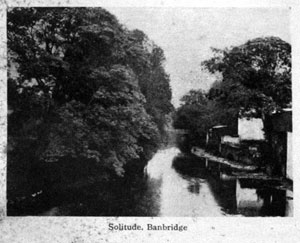
Banbridge is in the parish of Seapatrick, and the ruins of the old church may still be seen in a graveyard about a mile away. This very ancient ecclesiastical site is said to have been founded by St. Patrick. What was probably a holy well may be viewed beside the graveyard. The River Bann flows by in the valley, and here we feel ourselves to be at one of the cradles of Christianity in Ireland, and we can appreciate the beauty of the spot that attracted the patron Saint of the land.
There is a constant service of railway trains and motor buses to from Banbridge. The town is well situated as a centre for visiting much of County Down.If the traveller finds himself in Banbridge on the 13th of July, he will find amusement and insight into the history of the people by visiting the Sham Fight at Scarva, where immense crowds enjoy a summer picnic while celebrating the Battle of the Boyne in quaint fashion.
Lovers of the sport are here in a congenial atmosphere. The local links are a nine-hole course, well laid-out and carefully kept up. Visitors are made welcome at the cheap rate of two shillings a day or seven shillings and sixpence a week. A cricket field and tennis courts are pleasantly situated in the town. Tennis can be had at anominal charge. The Bann affords excellent brown trout fishing (free) for a stretch of about five miles distant. The Iveagh harriers hunt on Wednesdays and Saturdays during the season, and by the County Down Staghounds often meet near by.
In the Church Square stands a striking monument to one of the most distinguished of the sons of Banbridge, Captain Francis Rawdon Moira Crozier, R.N. Is it opposite the house where he was born in September, 1796. The statue is by the eminent sculptor Kirk, and the pedestal, with its four polar bears, is by the Newryman, W. J. Barre, the designer of the Albert Memorial (Belfast) and the Ulster Hall. The best authorities award Crozier the fame of having discovered the North-west passage. His statue in the Square where he played as a boy, is so made as to look towards the North-west where in some unknown spot he died.
No names in English literature attract more sustained interest than the children of the Rev. Patrick Bronte, Rector of Haworth, Yorkshire who was born in Emdale, a townland about seven miles from Banbridge, on St. Patrick's Day, 1777. One of the ten children of Hugh Bronte (or Prunty as the family were called locally), he was helped by the Rector of the parish and at the age of twenty-five set out for St. John's College, Cambridge. The crumbling remnants of the humble cottage in which the Brontes used to live still remain on the roadside, a pathetic link with the brilliant authoress of "Jane Eyre." Members of the family can still be found in the locality.
In Port Hope, Ontario, there is a monument to Joseph Scriven, author of the popular hymn -- "What a Friend we have in Jesus." He was a son of a Banbridge man, Captain John Scriven, and was born in a house near the town, Ballymoney Lodge.
A short distance from Banbridge is the historic village of Loughbrickland, which was well known before Banbridge rose to prominence. The lake, with its tiny island at Loughbrickland, was the scene of battles long ago. A stout castle used to guard the pass, but no trace of it now exIsts.
Tanderagee is not far away. The Cusher river flows through the district, and affords excellent trout fishing and coarse fishing, mostly free, but permission can be had on application to the owners to fish anywhere. There is good coarse fishing in river and lakes. A nine-hole golf course is open to visitors.
Bangor
Is situated at a distance of about twelve miles from Belfast, to which port passengers are booked by all the railway companies in the United Kingdom.
Visitors from England and Scotland wishing to reach Bangor by a short sea route can arrange to travel by daylight steamer from Scotland via Ardrossan or Stranraer, and the English Railway Companies have also connections by the daylight and night services via Stranraer.
Bangor is situated on a beautiful bay, to which it gives its name, and visitors to the North of Ireland travelling by the direct routes from Glasgow, Heysham, and Liverpool get a splendid view of the town, which lies at the entrance to Belfast Lough, justly famed as being one of the most beautiful arms of the sea in the kingdom. Passengers from the Midlands of England and Welsh districts will also find the route via Holyhead and Dublin most convenient for reaching Bangor. The coast scenery for miles around the town is surpassingly beautiful. There are few watering-places whose irregularity of the shore line produces a more pleasing diversity of scenic effects. The main street of the town descends a gentle hill to the Bay, the contour of which is followed in the building of handsome villas.
Before Canterbury, Bangor was a religious seat. Its abbey was founded by St. Comgall, who was born in 432; and in the succeeding centuries its fame as a centre of Christian learning and a nursery of missionary zeal was spread throughout the civilised parts of Europe.
Health, recreation, scenery, historical interest -- all these appeal to the holiday-maker, and are provided in abundance by Bangor.

The municipal authorities have kept the claims of the public health in the forefront of their programme, and as a result Bangor enjoys merited repute, not only in Ireland. but in England and Scotland, from which every year there is an influx of holiday-makers. The town is served by an abundant and pure water supply. The situation of the town on the slopes of picturesque Bangor Bay tends to natural drainage, so that in a short space of time after the heaviest rain the streets are dry again. The roads and footpaths are well kept. Well-equipped parks, and pleasure grounds make Bangor an ideal centre for a holiday, a place to which young and old can come for a few weeks with the assurance that they will return to their own homes and ordinary occupations reinvigorated in body and mind.
GOLF.
Realising the important place that healthy sport and amusement occupy to-day, a policy of providing recreations and amusements of the kind which appeal to visitors has been pursued for a number of years.
To Bangor belongs the distinction of possessing the first and only municipal golf course in Ireland. This fine links of eighteen holes is situated in picturesque surroundings to the west side of the town, at Carnalea. The original nine-hole course was for many years the home of the Royal Belfast Golf Club, which was the first Club in Ireland. The services of a professional golfer are available, and the scale of charges for play has been made out on a popular basis. Eighteen holes can be had for a shilling, and weekly, monthly and yearly tickets are available on special terms. There is an excellent pavilion where refreshments are obtainable at moderate charges.
In addition to the municipal course, Bangor possesses a very fine private links, the property of the Bangor Golf Club. Visitors are heartily welcomed and the scale of fees is moderate. Situated in the centre of the town, the course is noted far and near for the excellence of its greens. Sunday play is permitted.
GOLF, PUTTING, AND TENNIS.
Kingsland, a large pleasure ground adjoining the beautiful Ballyholme Bay, is largely devoted to public putting greens. This sports centre presents an animated picture on a summer evening with its gay groups of players and spectators, and in the foreground the crimson and white sails of the yachts of the Ballyholme Yacht Club.
Lawn tennis enthusiasts are admirably catered for, not only at Kingsland, but in the Ward Park, where a large area has been laid out in hard and grass courts. Tournaments open to visitors are organised frequently.
BOWLS.
A magnificent public bowling green, laid with Cumberland turf, is also provided in the Ward Park, and the excellence of its surface is well known not only to local players, but also to the many visitors from England and Scotland.
SEA BATHING.
Bangor is famed for the excellence of its bathing facilities. Deep sea, strand and pond bathing are all catered for. Pickie Rock is a name to conjure amongst aquatic enthusiasts of both sexes, and the frequent galas, organised by the Bangor Amateur Swimming Club (which numbers several Ulster and Irish champions in its ranks), are very popular alike with competitors and spectators. There is a fine tidal pond at Pickie, and facing the open sea there is a series of springboards and shutes, placed to suit every phase of the ebb and flow, either of which is equally good for bathing.
Skippingstone Ladies' Bathing Place is conveniently situated, and is reserved for ladies and children.
Beach bathing on the mile long strand at Ballyholme is indulged in to the fullest extent during the summer months. Bangor waters have the great advantage that there are no currents, and consequently no danger to swimmers at any state of the tide.
YACHTING.
Bangor is the principal yachting centre of the North of Ireland. Here is situated the headquarters of the Royal Ulster Yacht Club. The annual regatta is in July. It is under the auspices of the Royal Ulster Club that Sir Thos. Lipton issues his challenges for the America Cup. The headquarters of the Ballyholme Yacht Club are situated at Seacliffe Road, and this Club is renowned as a centre of sportsmanship and social life.
BOATING -- FISHING.
Through the enterprise of local boat-owners there is an excellent fleet of safe rowing craft for rowing in the Bay or for fishers. Motor boats also are provided and can be hired for cruisers to the picturesque Copeland Islands and other points of interest at moderate charges.
Ample facilities exist for fishing. Boating accidents are unknown.
MARINEPROMENADES.
Bangor has a fine marine promenade, over three miles in length, from which an infinite variety of beautiful land and seascapes are visible.
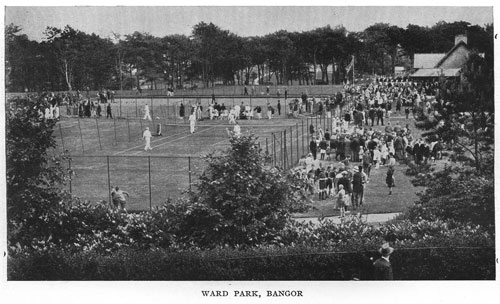
WALKS.
Charming and interesting walks there are in abundance around Bangor, and to the pedestrian the district is rich in exploration possibilities.
DANCING -- CINEMA -- CONCERTS.
There are a number of very fine and well-appointed dance halls in Bangor, where first-class orchestras are engaged daily throughout the visitors' season. Concert parties appear in the Arcadian Gardens nightly. There are pierrot entertainments on the Esplanade, while lovers of the "movies" are catered for in the Picture Palaces.
William Reid Clanny, M.D., first inventor of a safety lamp, was born in Bangor, in 1766, and educated in Edinburgh. It was in 1813, in connection with a "Society for the Prevention of Accidents in Coalmines" that he first exhibited a safety lamp, proving his confidence in it by experimenting in the Herrington Pit, amid such an atmosphere of gas that an explosion would have blown both Clanny and the pit to pieces. It was not until 1815 that Sir Humphry Davy turned his attention to the subject of safety lamps, and not until the 1st January, 1816, was his lamp tried in Hebburn Colliery, the "Geordie," George Stephenson's attempt, being almost simultaneous. There is no doubt, therefore, that to Dr. Clanny is due the merit of having been the first to conceive, and the first to carry into effect, the construction of a lamp to burn safely in the explosive air of coalmines, but the lightness and handiness of Davy's lamp secured tor it general recognition. The Society of Arts awarded Clanny their gold and silver medals, and his friends, headed by the Marquis of Londonderry, presented him with a silver salver and a purse of gold.
An hotel and boarding-house list and Official Guide, giving more comprehensive information, will be sent post free on application to the Town Clerk, Bangor, Co. Down.
Castlewellan
A thriving town, four miles from the fashionable Newcastle, lies at the foot of a mountain, and on the shores of a beautiful lake abounding with trout. Here stand the massive mansion of the Earl Annesley and the picturesque residence of the Earl of Roden. The name of the lake near by, Altnadua,"the cliff of the battle-axes," is eloquent of a stormy past.
Crawfordsburn
A charmingly situated village, with an old-world inn, is but two miles from Bangor, and not far away is Clandeboye, the seat of the Marquis of Dufferin, the first Marquis being the Governor-General of Canada and Viceroy of India. At Clandeboye, too, was born Sir Henry Blackwood, one of Nelson's greatest captains and most intimate friends, and the executor of his will.
Donaghadee
In former days was familiar to visitors from England, chieify as the port of arrival on the shortest sea-crossing between the two countries, which was then from Portpatrick on the Scottish Coast to Donaghadee. The establishment of the Stranraer-Larne service altered this -- a serious loss to both Donaghadee and Portpatrick; upwards of £150,000 had been spent on improvements to Donaghadee Harbour, and an even larger sum on constructing the harbour at Portpatrick, but now it has found a more attractive career as a pleasant and increasingly popular holiday resort.
The beach consists of a fine stretch of sand, from which safe bathing may be enjoyed, varied by clusters of rocks, and although there are no high cliffs the coastline is a distinctly interesting one. A long pier stretches out to a lighthouse, showing at night a red light, that is visible to vessels twelve miles out at sea. Rowing and sailing boats are available for hire at the Harbour, while coastal trips can be taken by motor boats. Good sea fishing is to be had either from boats or from the rocks, which jut out to sea at either end of the sea front. The principal catches are of cod, bass and pollack.
In addition to such essentially seaside recreations as bathing, boating and fishing, Donaghadee has an excellent 18-holes golf course on the immediate outskirts of the town, with a most attractive situation overlooking the sea. The Club House is a commodious building with a verandah running round it. Fees for visitors (introduced) are as follows:- Summer 3/6 per day, 15/- per week, 20/- per month; other parts of the year 1/6 per day (5/- on Saturdays), 7/6 per week, 20/- per month. The course is of naturally undulating ground, although artificial bunkers are also included. There is also a 9-holes putting course in the grounds of the Mount Royal Hotel.

Donaghadee is the nearest mainland town with good facilities for excursions to the Copeland Islands, a group of three islands lying just off the coast to the north of the town. Visitors can motor along the coast through the village of Ballywalter and Ballyhalbert with glorious sea views to the left, through the charming villages of Portavogie and Cloughey to the extreme point of the Peninsula at Portaferry, and return to Donaghadee by way of Kircubbin and Newtownards through Greyabbey, where the beautiful ruins of a Cistercian Abbey founded in 1193 are situated. Parts of the nave, choir and transepts survive.

The village of Groomsport, too, lies between Donaghadee and Bangor with a picturesque harbour. Groomsport found a. place in history in 1689, when Schomberg disembarked. with 10,000 men during the war that finally banIshed the Stuarts and put William III. on the English throne.
There are two good hotels at Donaghadee and in the Ards Peninsula, the hotels including the Nugent Arms at Portaferry, and Dunleath Arms at Ballywalter. There are good golf courses at Scrabo, Newtownards, Kirkistown, near Portaferry, and Helen's Bay, while Point-to-Point race meetings are held at Ballyhaft and Comber.
Further information regarding Hotels and Boarding-houses may, be obtained from the Town Clerk, Donaghadee.
Downpatrick
263/4 miles by rail from Belfast, and 21 miles by motor bus route, the capital and assize town of County Down, was a place of importance even before the Christian era and the advent of St. Patrick. Situated at the head of the picturesque Quoile estuary, which opens into Strangford Lough, it lies irregularly in a valley formed by hills of some elevation.
The Cathedral crowning the height adjacent to the great Norman Mount in the marshes, claims attention. It is believed to occupy the identical site of the Monastery founded by St. Patrick, and here, according to tradition, the remains of the Patron Saint are interred. His reputed grave is marked by a huge inscribed monolith. The Cathedral was successively destroyed in 1316 by Edward Bruce, the Scots invader, and in 1538 by Lord Deputy Grey, who for this and other acts of sacrilege was subsequently impeached and beheaded. After more than 250 years of desolation, at the beginning of the nineteenth century the stately edifice of to-day was reared on the ruins.
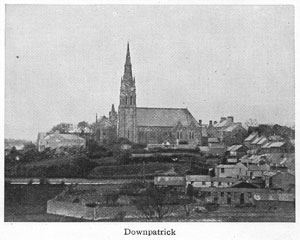
Within easy distance of Downpatrick stand, on a reach of the Quoile River, the now preserved remains of the Cistercian Abbey of Inch. There have likewise been preserved the Wells of Struell, dating back to pre-historic times, and transformed into a Christian place of worship by St. Patrick; and the ancient practice is still continued of sick persons resorting thither on St. John's Eve in the hope of cure from the waters. Near by, on Slievenagriddle mountain, are the remains of a cromlech, and a remarkable stone circle. To the west of Ballynoe, is one of the finest stone circles in Ireland, probably belonging to the Bronze age.
When Downpatrick was a Parliamentary Borough, one of its most notable representatives at Westminster was John Wilson Croker, one of the founders of the "Quarterly Review.".
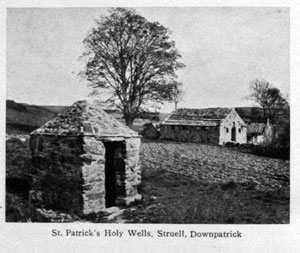
The Marshes, referred to above, afford the best duck-shooting imaginable. There are ample facilities for fishing in the neighbourhood. The town is in the heart of Lecale, the country of the East Down Harriers, and in part also of the County Down Staghounds, and every year the Hunts two-day steeplechases are held here. Tennis, cricket, hockey, and football flourish locally in their respective seasons. There are two social clubs -- the long established Down Hunt, composed almost exclusively of country gentlemen, possessing interesting rooms at the Mall; the other, the County Club, situated in Irish Street.
Dromore
Nine miles from Lisburn, is chiefly notable for its ecclesiastical history.
Buried in the Cathedral are the bodies of Bishop Jeremy Taylor, the author of "Holy Living," and one of the great Churchmen of history; and of Bishop Percy. "A man out of whose company I never go without having learned something," said Johnson of him. "I am sure that he vexes me sometimes, but I am afraid that it is by making me feel my own ignorance." The work that made him famous was all done before he came to Ireland; he was then getting old, and the County Down of 1782 was very much out of the world. His "Reliques of Ancient English Poetry," have instilled in thousands a love of the ballads of their country, while his song --
"0 Nannie, wilt thou gang wi' me, Nor sigh to leave this flaunting town? Can silent glens have charm for thee, The lowly cot and russet gown?"
is a delightful example of the unselfish demands of mere man.
Dromara
Lies in the very centre of the flax-growing district of Ulster, while in the summer it is a most beautiful sight to see fields of flax in full blossom (blue and white). Here we have the newest and most up-to-date mill erected for the new process of working flax from the time it is pulled and dried until it is made into yarn, which will give employment to about 500 people. O'Reilly's Hotel may be recommended; and visitors can travel to Dromara by either rail or bus.
Dundrum
Is a fishing village on a rock-strewn bay three miles from Newcastle. A coal, cargo, and passenger steamer plies twice a week from here to English and Scottish ports, and an extensive import trade exists. Ballykinlar Camp, a training ground for H.M. Army, is two miles away. The history, of Dundrum runs back to the legendary past of King Cormac MacNessa and the Red Branch Knights, and its castle was the scene of many battles, till finally dismantled in 1652 by the Parliamentarians:
Hillsborough
Four miles beyond Lisburn, has a fine park, enclosing a 17th century fort, in which William III. is said to have slept in 1690, and which is visited by large numbers of tourists. On the hilltop stands a monument to the 4th Marquis of Downshire.
The Maze Racecourse, an historic venue, has long been associated with Hillsborough.
The official residence of the Governor of Northern Ireland is Hillsborough Castle.
Holywood
Four miles from Belfast, is beautifully situated on the eastern or County Down shore of Belfast Lough, and is backed by an extensive range of hills, which rise with a gentle slope from the water's edge to a height of some 700 feet.
The town has been a place of note since the seventh century, at which period a church is believed to have been founded in it by St. Laisren, and it is recorded that King John, when journeying from Carrickfergus to Downpatrick, on the 29th July, 1210, halted at Holywood -- "Apud Sanctum Boscum," the name Sanctus Boscus, or Holy Wood, having been given to it as early as the period of the English invasion.
About the year 1200 a monastery of the Third Order of St. Francis, or Franciscans, was founded. This monastery, which was tenanted by about 400 monks, stood near the ruins of the present old church, and occupied the site of the church believed to have been founded by St. Laisren. A short distance from the old church, in the ground of Millmoat, is a large ancient rath or funeral mound, supposed to be the tomb of some mighty chief who flourished long prior to even St. Laisren's time. The monastery was attached to the great monastic establishment at Bangor, founded by St. Comgall, and with other monasteries at Bangor, Newtownards and Movilla, was burned by Sir Thomas Brian MacFelim O'Neill, Lord of Clannaboy in 1572, in order that Sir Thomas Smith, Secretary to Queen Elizabeth, might have no opportunity of placing garrisons In them. In the graveyard which surrounds the old church, there are gravestones dating from 1630, and an elaborately carved stone of about six feet in height, which has been proved to be of great antiquity, was discovered some years ago embedded at a considerable depth on the northeast side of the old graveyard, and is now preserved in the belfry.
The town is one of the chief military stations in Ireland, and about a mile outside it are the Palace Barracks, tastefully laid out amidst charming rural scenery. The War Office has also acquired the Kinnegar for drill purposes and rifle practice.
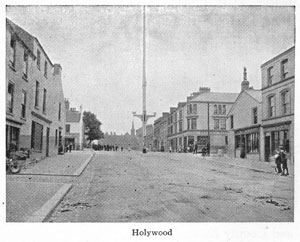
Holywood has prospered with rapidity, is a favourite residential centre, and contains a Maypole (probably the last of its kind in Ireland), standing at the junction of High Street, Shore Street and Church Street, which is an immense Canadian spar about 85 feet above ground and 20 feet under it. The ceremony of dressing the Pole with bunting on May Eve is still continued The district is rich in interesting and delightful walks, and attention may be directed to the curious old caves in Cultra Glen, whIch are well worth exploring; whilst about a mile above the Parish Church is Schomberg's HIll, where it is supposed William's Army lay in marching from Groomsport to the Boyne.
Excellent rail and bus servIces are provIded connecting with Belfast and the County generally.
Sport is well represented by cricket, golf and tennis. the local golf links, laid out on the face of the hills overlooking the town and Lough, with extensive views of County Antrim, and the Royal Belfast Golf Links at Craigavad, on elevated ground on the shore of the Lough, two miles distant, are each open to visitors. The Royal North of Ireland Yacht Club House, situated at Cultra, is within a mile from the town.
Kilkeel
On the County Down coast, makes an ideal centre for many excursions.
To the angler it must be a favourite resort as the Annalong River, the Ballykeel River, the Kilkeel River, the Causewater River, the Kilbroney River, the Grann River, and the White Water River, which passes through Mourne Park Demesne, the residence of Earl Kilmorey, are all in the vicinity. Fishing is free, and brown trout and salmon are the principal fish caught. Kilkeel district is well served by bus from Warrenpoint and from Newcastle in connection with the Belfast and County Down Railway.
An old roofless church, built inside an earthen rath, and a dolmen with a capstone of granite, measuring 10 x 8 x 4 feet, are often visited by antiquaries, whIle at Dunavan is one of the finest Kistvaens or "Great Graves" in Co. Down. At the village of Duavil, three miles from Kilkeel, is Fort Dun-na-bhfal, a fort with a double rampart the outer wall being 10 feet high, and the inner one 18 feet high. Five miles from Kilkeel at Greencastle, is an old Norman Castle, and a dolmen, the capstone of which is estimated to weigh 30 tons, while at Killowen is the one time residence of the famous Lord Chief Justice of England -- Lord Russell of Killowen.
There are two golf courses near Kilkeel open to visitors. one (2/- a day), a 9-hole course at Cranfield, on the shores of Carlingford Lough, and the other, an 18-hole course at Warrenpoint (2/6 per day).
Kilkeel Tennis Club welcomes visitors.
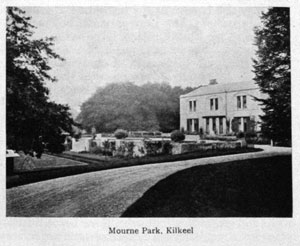
It is a splendid centre for the tourist, as there are the most up-to-date travelling facilities in all directions by bus and rail, and ample opportunity is presented for mountaineering, bathing and rambling. The main coast road from Newcastle to Warrenpoint is justly celebrated for its magnificent scenery. Those wishing a closer acquaintance with the mountain scenery by motor can proceed by the only road through the mountains from Kilkeel over the Cairn Brae and Spelga Pass to Hilltown, a distance of 10 miles. At Spelga the River Bann rushes down a narrow rocky defile high up on the side of which the road is perched. Care should be exercised at the steep hair-pin bends.
Another beautiful motor run is from Rostrevor to Newcastle via Hilltown and Bryansford, on an excellent road. Near this road at Clonduff there is an ancient church, the birthplace of the Maginnis family, the ancient Lords of Iveagh.
Midway between Newcastle and Kilkeel lies the village of Annalong, formerly a fishing village and a port for granite export, but now eager to cater for tourists. There are several good boarding-houses and an hotel. It is this district which Mr. "Lynn Doyle" has made famous with his pen, and it is also famous as the birthplace of General Chesney, whom De Lesseps described as the "Father of the Suez Canal.'
Newcastle
The picturesque Irish seaside resort of Newcastle, County Down, is rapidly advancing into that prominence which its charm amply justifies. Nestling at the foot of Slieve Donard, stretching for a distance of two miles along the beautiful bay of Dundrum, fronted by a vast expanse of sandy beach, woodlands, and scenic beauty, with a golf course (the famous Royal County Down), and possessing every convenience tending to meet the needs of holiday-makers, Newcastle is an ideal centre for health and enjoyment.
Electric light, splendid bathing facilities, well-kept roads and granolithic footpaths, three beautiful esplanades, street watering, cleanliness, and order, are amongst the improvements effected in recent years.
The district is rich in historical associations. The town derives its name from a castle erected by a chieftain of the clan McGinnis near the mouth of the Shimna river towards the end of the fifteenth century. The Bloody Bridge, Maggie's Leap, Rury' s Fort, the cromlech at Sliddery Ford, and Dolly's Brae, are in the immediate neighbourhood. Downpatrick, the scene of St. Patrick's early labours, and the Bronte district near Rathfriland, are also within easy reach.
The town permits of easy access from all parts, the splendId servIces of motor buses connecting it with Rostrevor and Warrenpoint by the coast road, and the Belfast and County Down, and the Great Northern (Ireland) Railways, with Belfast Dublin, and the various centres and shipping ports. The journey from Belfast and Dublin can be accomplished in one, and three and a half hours respectively. Cheap travelling facilities are also available from all parts of the Kingdom.
Within easy reach of Newcastle, and open to the public, are the seats and demesnes of the Annesley and Roden families. The Annesley Demesne at Castlewellan possesses many fine old trees, a pretty lake, and a beautiful castle of the Norman style of architecture. Tollymore Park, the charming residence of the Earl of Roden, is about two miles distant from Newcastle.
Splendid hotels (including the Slieve Donard, with its several hundred rooms, built within recent years by the Belfast and County Down Railway Company at a cost of from £150,000 to £200,000), boarding-houses, private houses, and comfortable apartments, are a feature of the town's popularity.
Those who are inclined to spend a quiet holiday can revel in the beauty of nature along the sand dunes watching the never-ending motion of the blue waves expending themselves at their feet, whilst above, in the course of the setting sun, stands forth in peaceful repose the undulating chain of Mourne, with the fine old structure of Donard Lodge, the residence of the late Dowager Countess Annesley, situated in the centre of the trees. Farther up, at an altitude of 700 feet, are situated the Donard granite quarries, from which large quantities of granite setts and dressed granite stone are exported all over the country.
There are ample fishing possibilities in the Shimna, Maghera, Ballylough, Moneycarragh, and Kilkeel rivers, or small boats can be obtained at a reasonable cost to ply the line in the waters of the bay. The lawn tennis and croquet courts are situated amidst picturesque surroundings, are in keeping with the gentlemen's and ladies' golf courses, and, like the latter, are the venue of many open championship events.

The Mourne Mountains, forming as they do the highest mountain range in Ulster, and the most easterly highlands in Ireland, yield much of interest to the tourist whose mind is drawn towards nature and her works. It is almost impossible to find in any part of the world, at least within such a limited area, the varied flora to be found here -- alpine, woodland, and maritime.
The climb to the top of Slieve Donard, nearly three thousand feet, is not difficult. In less than two hours the climber can reach the top, and, if the day be clear, can see spread below him a wide expense of countryside with innumerable homesteads. St. John's Point Lighthouse is just across the bay, while in the distance the Isle of Man rises above the water. Slieve Gallion and the Sperrin Mountains in Derry and Tyrone, the bold outline of the Scotch coast, and even the Donegal Mountains can be seen.
The Silent Valley, locally called the "Happy" Valley, the main source of Belfast's water supply, is situated a short distance from Newcastle.
Further information regarding Hotels and Boarding-houses may be obtained from the Town Clerk, Newcastle.
Newry
"The Gap of the North" and centre for the famous Carlingford Lough and Mourne Mountain district, is one of the most progressive and up-to-date towns in Ireland, and stands at the head of Carlingford Lough amid a wealth of beautiful scenery, equally attractive to the sportsman, health seeker and antiquarian. The town is one of the most ancient in Ireland, and on account of its position on the Border of the Pale, it has witnessed many stirring historical events. Within reach of Newry are early Christian and Druidical remains. St. Patrick is said to have planted a yew tree here, from which fact the town derives its coat of arms and name. An abbey was founded in Newry in 1140A.D., by St. Malachi, and many traces of it are still to be found.
From the eighteenth century onwards the town assumed importance as a commercial centre, and many facilities foor its advancement were granted by the old Irish Parliament -- for instance, the making of the Newry Canal.
The district around Newry is teeming with historical memories. Slieve Gallion, the "most storied mountain in Ireland"; Foughart, said to be the birthplace of St. Brigid; Ballynahinch, Carlingford, etc., all famous in history. Narrowater Castle, which occupies a commanding position on the river bank between Newry and Warrenpoint, and was the scene of many warlike encounters, is well worthy of a visit, also the modern castle, with its beautiful grounds and park -- the seat of the Hall family.
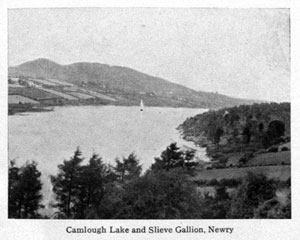
Newry has many interesting associations, being the birthplace of Lord Russell of Killowen, and Sir Patrick Jennings, while in the immediate district were born -- Thomas Darcy Magee, John Martin, Captain Mayne Reid, etc. John Mitchel lived the greater part of his early life in Newry, and also ended his days here, where his remains are buried.
There are many facilities for visiting the places of interest about Newry, and special mention should be made of the railway and coach tours around the coast, via Warrenpoint, Rostrevor, Kilkeel, Newcastle, etc.
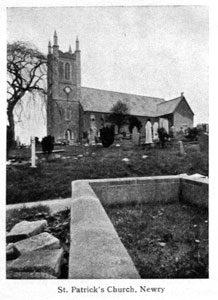
The River Bann, at Hilltown, about eight miles from Newry, is a well-known trout river. The scenery in the locality is renowned for its beauty. There is a good hotel at Hilltown, which is largely used by anglers. There are also first-class omnibus services to Hilltown from Newry, Newcastle and Warrenpoint. There are many historical objects in the districts, including the old Clonduff Church, and a famous cromlech, in the town land of Goward, a short distance from Hilltown. There is an ancient mound in the town land of Ballyaughian, beside the village of Hilltown.
Newtownards
Five miles from Bangor, is an important, populous, and prosperous town at the head of Strangford Lough, with the mountain Scrabo towering boldly over It. In the graveyard attached to the Church, which was formerly a monastery in 1244, are the tombs of many members of the Londonderry family. Close to Newtownards are the ruins of the Abbey of Movilla, founded in the sixth century by St. Finian, whose death occurred in 572. The ruins are 107 feet in length.

Permission to visit the demesnes of the Londonderry family, with all the interesting relics of bygone ages, may be obtained from the Londonderry Estate Agent in Newtownards.
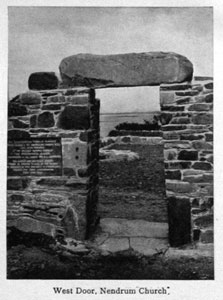
Around Newtownards and down the Ards Peninsula are many lovely towns and villages, such as Comber, Killyleagh, Greyabbey, Kircubbin, Portaferry, Cloughey, Portavogie, Ballyhalbert, Ballywalter, Millisle, Groomsport, Helen's Bay, and Strangford. Hotel accommodation is available in several of these towns, and boarding-house accommodation is obtainable in all of them. There are good railway and bus services to all the towns and villages in the Ards Peninsula, and places of historic or other interest include Scrabo Tower at Newtownards, the old Cistercian Abbey ruins at Greyabbey, the famous ruins at Nendrum four miles from Comber, and Helen 's Tower between Newtownards and Bangor, the memorial of the 1st Marquis of Dufferin and Ava to his mother.
Golfers will find a nine-hole course on Scrabo, and another at Kirkistown.
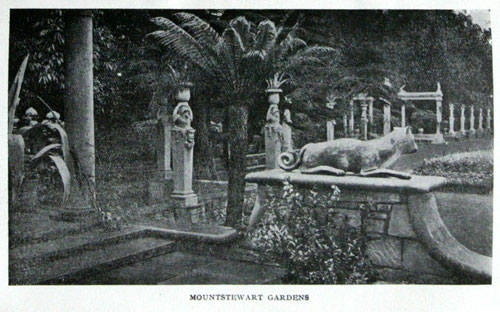
Among the famous men who came from this district was Major-General Sir R Rollo Gillespie, born in Comber in 1786, who lived a life crowded with adventure. On 31st October, 1814, Gillespie fell in the assault on Kalunga in Nepal. He was shot through the heart at the head of the 53rd Foot after crying -- "One more try for the honour of Down." He has a monument, by Chantrey, in St. Paul's, and a column to his memory stands in his native town. His marvellous ride to Vellore is the subject of a spirited poem by Henry Newbolt:--
"Alone he came to false Vellore,
The walls were lined, the gates were barred.
Alone he walked where bullets bit,
And called above to the Sergeant's Guard."
Sir Hans Sloane, physician and naturalist. whose name will probably outlive that of any other Ulsterman, was born in Killyleagh, 16th April, 1660. Studying in London and France, collecting an herbarium in Jamaica, his name became a synonym for learning and kindness the Continent over, while at home honours were heaped upon him. President of the College of Physicians, an Associate of the French Academy, and Sir Isaac Newton's successor as President of the Royal Society, he had also been created a baronet and appointed Royal Physician. His museum and library of 50,000 volumes and 3,560 MSS. formed the commencement of the British Museum, and his estates in Chelsea the fortune of the Cadogan family, He was buried in old Chelsea Church.
Rathfriland
(" Frielan's Fort"), on a lofty hill, about three miles from Hilltown, is an interesting old town, containing the ruins of an ancient castle, belonging to the Magenis sept, once Lords of Iveagh. One of its bygone notabilities was the Rev. Henry Cary, vicar, whose translation of Dante's "Divine Comedy," a wonderful work for a country clergyman. still finds publication.
Rostrevor
"Warrenpoint and Rostrevor, a mile or two apart, sit at the south side of the Mourne Mountains, mild and sheltered and close to scenes of great beauty. Hanging over Rostrevor is Cloughmore, the Big Stone, which was thrown across the mountains by Finn MacCoul, the same that tore a piece out of the earth and threw it into the Irish Sea and made the Isle of Man. It was at a Scotsman that he threw the Cloughmore, and you will understand that he must have had great provocation, for the stone weighs about forty tons. Near to Rostrevor is the Fairy Glen.
"Nature has been more than bountiful here, as elsewhere in Ulster she has been lavish. She has not been content to endow Rostrevor and Warrenpoint with a lovely lough and pleasant air and fine mountain views, but has added to them the magnificence of the Mournes. They share this magnificence with Newcastle and Kilkeel. I will not say that the road across the Mourne Mountains is the most beautiful in the world. I will not even say that it is the most beautiful in Ulster, though there are some who stoutly assert that it is. But will say that it is nearly unmatchable for its beauty."
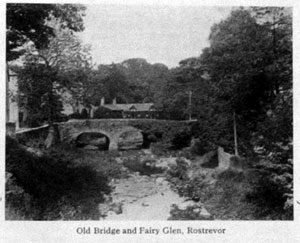
In the town stands a handsome monument to General Ross of Bladensburg, another of Ulster's famous soldiers, so named from his victory at that place in 1814. He also captured Washington, but was killed three weeks later at Baltimore.
Rostrevor is a delightful old-world beauty spot. To those who love tranquility in a gorgeous setting of lough, mountain, wood and dingle-dell, one cannot do better than Rostrevor. To the west you have the wooded southern spurs of the Mourne range, to the north the mouth of Carlingford Lough, just like a Norwegian fjord; to the east the Carlingford mountains beyond the lough; to the south the estuary with pretty Warrenpoint. The views to be obtained from the mountains, embracing even the Isle of Man, and down south to the Wicklow Mountains, are only limited by one's climbing capacities. The Girls' Friendly Society have a Holiday Home at Rostrevor, and few districts in Ireland have in so small an area such a number of country seats, villas, schools, and houses of the well-to-do.
Golf can be had at Warrenpoint, fishing at Hilltown, bathing at Woodside, and motor runs in abundance round and through the Mourne Mountains. Boarding-houses are well situated near the shore. In summer a service of motor launches is in operation between Warrenpoint and Rostrevor, and Rostrevor and Greenore, at the mouth of the lough. Dancing, pictures and aquatic sports are to be had at Warrenpoint. One could call Rostrevor the Hove of Warrenpoint, a little over an hour from Belfast by road or rail, and a little over three hours from Dublin .
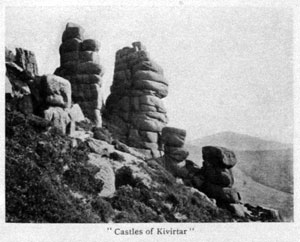
The Great Northern Hotel, which is owned by the Railway of that name, has recently been renovated and re-decorated, and a new ball-room added, which makes it an ideal all year round resort.
Saintfield
Among famous men associated with Saintfield was Francis Hutcheson, the philosopher, who was educated here, in Killyleagh, and Glasgow. In 1729 he was appointed professor of moral philosophy in the University of Glasgow, and thence til his death in 1747 seems to have done the work of half a dozen men in lecturing. He was a pioneer of the so-called "Scotch school" of common-sense philosophy.
Warrenpoint
Co. Down, is magnificently situated on a promontory on the north-eastern shores of Carlingford Lough -- one of the most beautiful arms of the sea that indent the Irish coast line. On the south-eastern shores of Carlingford Lough the western spurs of the Mountains of Mourne roll down to the sea, whilst on the opposite shore Finn MacCoul stretches his noble length along the majestic . summits of the Carlingford Mountains, which extend along the western shores of the bay to the old frontier town of Newry.
Warrenpoint is 51 miles by rail from Belfast, and 82 miles by rail from Dublin, with which places it is connected by good services of express trains. There are also up-to-date motor services directly to Belfast and Dublin. English tourists can reach Warrenpoint by the following routes -- L.M.S. Holyhead and Kingstown, or North Wall (Dublin); Belfast and Heysham; Larne and Stranraer; also by Belfast and Liverpool; and by G.W.R. via Birkenhead, Liverpool and Belfast. Scotch visitors can travel by the following -- Belfast and either Ardrossan, Glasgow, or Ayr; also by L.M.S., Larne and Stranraer. Visitors can book direct from all the principal English stations, tourist tickets being obtainable any day in the week, and excursion tickets on Fridays only.
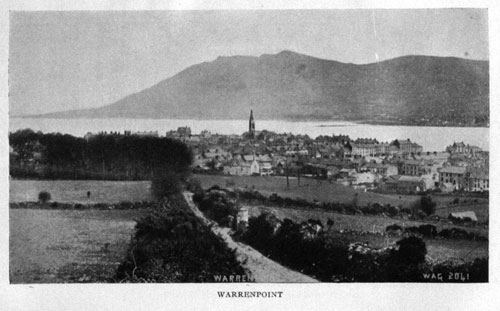
Golf -- An excellent 18-hole golf course, with licensed club premises attached, is open to visitors every day, including Sundays. VIsitors' fees -- Ladles, 2/- per day; Gentlemen. 2/6 per day.
Tennis -- Visitors can enjoy this popular game on the MunicIpal Tennis Courts In the Municipal Gardens at the following terms -- 6d. per hour, or 2/6 per day. Weekly and season tIckets are issued at reduced terms. and tennis tournaments are organised for visitors during the season.
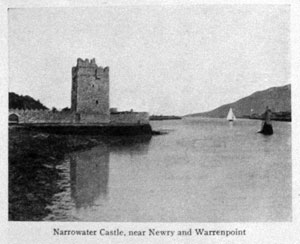
Carlingford Lough is remarkably safe for boating. and all rowing boats plying for hire are licensed by the Council. A fleet of motor boats and excursion steamers make delightful trips to Rostrevor, Omeath and Carlingford, and special cruises on Carlingford Lough.
The Baths are the most up-to-date and best equipped in Ireland, and are open daily. The charges for swimming. ponds are -- Adults, 3d.; Young Persons, 2d.; Hot Salt Baths, 1/4.
For mountain climbers there are many excellent walks in the Mourne and Carlingford Mountains, and all information regarding same can be obtained from the Town Clerk, Warrenpoint.
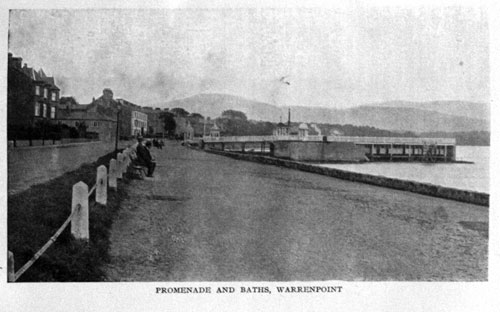
Warrenpoint has associations with many notable men -- General Warren, a General on the American side in the War of Independence, was born at Beach Cottage. He was killed in the Battle of Bunker's Hill. Thomas Caulfield Irwin, poet author of"The Potato Digger's Song," and other poems, was born at Newry Street. "Carrol Malone" (James Burnside), another poet, author of "The Croppy Boy," etc., was born at Carvill's Posting Establishment, Church Street. Other famous persons born in the district include the Bronte sisters, Emdale Forth. Drumballyroney; Lord Russell of Killowen; Major-General Ross of Bladensburg, General on the English side in the War of Independence, born at Rostrevor.
Historical objects include -- Clonallon Church. The site of the present church has been used for ecclesiastical purposes since the sixth century.
The ancient rath known as Rathturret is about thirty minutes' walk from the town; it is a good specimen and in an excellent state of preservation. There is a cromlech at Burren and a stone used for grinding corn in the same townland, about an hour's walk from Warrenpoint.
Old Castle, at Narrowater, built in 1663, stands on the site of a former castle built in 1216. The ruin, which is well preserved, picturesquely stands at the narrow portIon of the Lough, about twenty minutes' walk from Warrenpoint.
Cloughmore is a great boulder, about forty tons in weight, standing on a shoulder of the mountain overlooking Rostrevor at an elevation of 1,000 feet.
Yelverton Chapel, at Killowen, about four miles from Warrenpoint, figured prominently in the celebrated "Yelverton Marriage Case."
The ruins of the ancient Church of St. Bronach, at Kilbroney, are about four miles from Warrenpoint.
There is good trout fishing in the Bann River near Hilltown. Other places in the district available are the Moygannon River, Rostrevor River, Ryland River, Two Mile River, and the Clanree River. Coarse fish can be caught in the Newry Canal.
Co. Fermanagh
Belleek
Contains the only Porcelain Factory in Ireland, and is noted for the lovely Parian and other ware manufactured there. It is charmingly situated in the midst of delightful scenery, and holds the sluice gates which were erected for the purpose of regulating the traffic between Upper and Lower Lough Erne. There is good trout fishing around Belleek, Rosscor, Boa Island, and Kesh. Lough Erne is at its best during the May-July season.
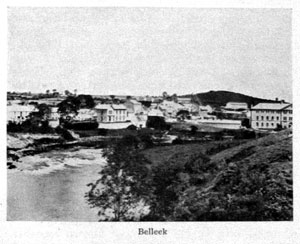
Belcoo
Is a pretty village ten miles from Enniskillen. It can be reached from Enniskillen by car, or rail on the Sligo Leitrim and Northern Counties Railway. Lough MacNean, the Marble Arch, and the Hanging Rock should be visited. There is a magnificent panorama from the road on the hills overlooking the Hanging Rock and Upper and Lower Lough MacNeans. On these hills are a number of Stone Circles. The Marble Arch, which is on the Estate of the Earl of Enniskillen, is a beautifully wooded glen in which will be found underground and open rivers and a number of remarkable caves. PermIts to visit the Marble Arch should he obtained at the Estate Office, Middleton Street, Enniskillen. Tourists motoring to the Marble Arch and Hanging Rock, should proceed by Florencecourt, Co. Fermanagh, to avoid border difficulties at Belcoo and Blacklion. The road through the hills overlooking the Hanging Rock commences at Gortatole, and is altogether in Northern Ireland.
Enniskillen
The island capital of County Fermanagh, is an ancient town situated in the midst of scenery of surpassing beauty and charm. "Nothing in Great Britain -- perhap's nothing in Europe" -- wrote Mrs. S. C. Hall. the well known traveller and writer, in referring to the district around Enniskillen --"can surpass the view. It is impossible to exaggerate in describing the loveliness of the whole locality." "How many thousands are there," she exclaims, "who, if just ideas could be conveyed to them of its attractions, would make theIr annual tour hither instead of up the 'hackneyed and soddened Rhine' -- infinitely less rich In natural graces, far inferior in the studies of character it yields, and much less abundant in an enjoyments that can recompense the traveller."
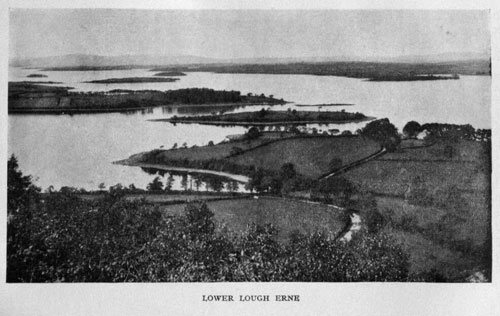
And in another place she declares that "whichever way one turns it is impossible to choose amiss in such a charming region."
Formerly a borough with Charter dated 1612, granted by James I., the town has had a very notable historic record.
The town gives its name to the famous 6th Inniskilling Dragoons and 27th Royal Inniskilling Fusiliers, and for over 200 years -- up to the year 1926 -- was an important military centre.
The old Castle of Enniskillen, situated at the west end of the town, is now included in the Castle Barracks. It was the scene of many a bloody affray in times gone by.
The Public Park, Porthill, is a well appointed and carefully preserved pleasure ground. It contains a noble pillar, erected in memory of General the Hon. Sir Galbraith Lowry Cole, second son of the first Earl of Enniskillen.
The town is fortunate in having a fine nine-hole golf course, conveniently situated and merging on the shores of Upper Lough Erne. Visitors are welcomed.
Several hard-court tennis clubs flourish, and are open to visitors who should apply at the Town Clerk's Office for information.
Visitors interested in yachting should communicate with the Secretary, Lough Erne Yacht Club, East Bridge Street. The Club premises are equipped with billiard rooms, reading and card rooms, etc., and the Club is noted for its open hospitality .
Motor boats are to be obtained at reasonable rates, and provide the best means of exploring the many wooded islands, and of enjoying the scenic variations of Lough Erne either in its upper or lower reaches. Particulars will be gladly given at all hotels.
Portora Royal School was founded by Charles I. in 1626, and was richly endowed. Its boys hail from all parts of Ireland, and their number includes many from across the channel. The school buildings are situated on an eminence overlooking the Lough, and a healthier, or more delightfully picturesque site could not be imagined.
At Bell-Isle, in Upper Lough Erne, the "Annals of Ulster" were written by Cathal Maguire about the fourteenth century.
At Devenish, in Lower Lough Erne, there stands one of the most beautiful Round Towers of Ireland. Antiquaries will find on this island much of interest, including remains of an old monastery of St. Molaise, priory and burying ground containing a finely preserved old Irish Cross.

In the Lower Lough are many other islands worthy of a visit -- White Island with its ancient church, beautiful doorway, and mysterious sculptures, Innismacsaint with its old abbey and stone cross dating back to the sixth century.
In fact the whole lake district abounds in ecclesiastical antiquities, where in the words of Whittier --
"-- circling ever their narrow range,
Quaint traditIons and legend strange,
Live on unchallenged, and know no change."
There is a first-class road round the whole of the Lower Lough, from which many indescribably beautiful views of the lake may be obtained. On this circular tour the visitor will pass Enniskillen, Portora, Ely Lodge, Magho Heights, the Broad Lake, Rosscor Bridge, Castlecaldwell, Craigavon Bridge, the Boa Island, Portinode Bridge, Kesh, Crevenish Castle, Aughinna Bay, White Island, Lisnarick, Castle Archdale, Lough Erne Hotel, and St. Angelo. There are many beautiful drives in the vicinity, with scenery similar to the Connemara district, such as those from Enniskillen to Garrison, via Carrick Lake and Correll Glen, returning by Lough MacNean, or from Enniskillen to Cashel Cross, via Derrygonnelly and Knockmore Cliffs, returning by Lough MacNean.
Crom Castle, the beautiful seat of the Earl of Erne, on Upper Lough Erne, may be visited on Fridays. The grounds contain the finest and most famous of the Irish yews. Two hundred persons can be seated under its branches. At Crom was born the most notable of Ulster Novelists, Mr. Shan F. Bullock; the "Loughsiders" is a tale of the Upper Lough. Boho caves are also worthy of a visit, and at Wattlebridge, near Newtownbutler, may be seen one of the largest Stone Circles in Ireland. There is also a Stone Circle in the Castle Archdale Deerpark. There are numerous ruined Plantation Castles at Castlehume, Crevenish, Crom, Monea and Tully. There are two famous Spas about one mile from Swanlinbar (Co. Fermanagh). Pike, perch, bream, and roach abound in all parts of the Loughs.
The Lough Erne Hotel is a luxuriously appointed tourist hotel, situated on an eminence in the heart of the Lower Lough. It commands one of the most fascinating of all the lovely views to be had in the district, and is an ideal spot for the city man in search of rest. It is about seven miles from Enniskillen, and can be approached either by motor boat or car. Enquiries regarding accommodation at this hotel should be made well in advance from the Manager, Lough Erne Hotel, Killadeas, Co. Fermanagh.
The hotels in Enniskillen itself include the Imperial, Royal, Railway, Ulster, Erne and Picotee.
Further information regarding Hotels and Boarding-houses may be obtained from the Town Clerk, Enniskillen.
Garrison
Is a village of rare beauty, situated about three miles from Belleek on the shores of Lough Melvin. It has two hotels, and is a favourite resort for anglers. The scenery all round is good. The lake is famous for salmon and trout fishing. The "gilaroo" trout, which, it is said, is not to be found in any other Irish water, may be caught here in large numbers.
Knockninny
Is a beautiful spot on the Upper Lake, about seven miles from Enniskillen. An immense mound, known as "Knockninny Rock," rises to a considerable height from the lake shore. At the bottom of the rock close to the hotel is Ninian' s Well, which is stated to contain very beneficial waters.
Lisnaskea
Nine miles from Enniskillen, and half a mile from Lough Erne, is justly admired for its beautiful scenery.
Pettigo
The town is situated partly in Co. Donegal (in the Irish Free State), and partly in Co. Fermanagh (in Northern Ireland), and within three miles of the celebrated pilgrimage of Lough Derg.
Co. Londonderry
Castlerock
The town is about half-a-mile from the main road. Here there are picturesquely straggling groups of houses and a splendid sea front. Here, too, the road passes through a rich avenue of trees which gradually expand on the one side to Downhill, on the other to Port Vantage. Downhill cliffs are of the same colossal character as those at Fair Head or the Giant's Causeway, towering to a minimum height of 250 feet. For about a mile Derrywards they overhang the road; Benevenagh -- a veritable sea of emerald foliage -- shreds its height of 1,260 feet in a decidedly picturesque fashion. Countless cascades tumble over these mountains, and the intervening spaces are decked with mauve coloured flowers and wild roses.


Downhill is the beginning of a wonderful arc of sand extending to a distance of from 6 to 8 miles to Magilligan Point. The vista from here is wonderful; away to the east is Rathlin Island, where R Bruce watched the spider which led him ultimately to Bannockburn; a slight gap and the turrets of the Giant's Causeway, and the fashionable seaside resorts of Portrush and Portstewart are plainly visible, and the Mussenden Temple stands out in clear outline. To the west lies Donegal and the delightful panorama right up to Innishowen Head.
Castlerock has excellent rail and bus connections. It has a fine natural 18-hole championship golf course, where the Men's Irish Close, Ladies' Irish Close, and Professional Championships have been played. There are good hard tennis courts, and the river Bann -- a river famous for its salmon and trout-runs close to the town. The Golf Hotel and Stewart's Hotel, also many good boarding-houses cater extensively for the visitor. There is a good hotel at Downhill. Downhill House, the seat of the Bruce family, was built by the very extraordinary prelate, Augustus Hervey, Earl of Bristol and Bishop of Derry.
Coleraine
Is a pleasant borough nestling in the Bann valley, with a secluded beauty all its own. Its name, which it owes to St. Patrick himself is a word-poem, meaning "the corner of the ferns."
One of the chief charms of this lovely district is the wood of Mountsandel, in which stand the remains of a once moated fort, and, indeed, royal palace, for the soft green contour of the dun of Fintan, King of the third of Ulster in the first century, can be seen even from the Bann Bridge in the centre of the town. It is worthy of note that the Book of Leinster contains a detailed account of a feast held there almost two thousand years ago.
Four miles westward, on the old mountain road to Limavady, stands the site of Dun Ceithern, which was the headquarters of the Red Branch Knights. This lovely woodland is within a mile of the town, and, as well as being historical and beautiful, leads to a viewpoint for the Salmon Leap.
According to the Venerable Bede, the Bann and Bush were full of salmon in the year that Christ was born, and the supply never seems to have failed. The Bann is a famous fishing river.
The following is a list of the charges for angling on the fiver Bann :-- Single rod and line licence (salmon and sea trout), £1 10s.; season ticket (salmon and sea trout) from the sea to the Agivey Bridge, £5; weekly tIcket, £1.
Salmon and sea trout from a boat Toomebridge Weir wall on the south side of Portglenone demesne -- for the season, £1 10s.; weekly ticket, 5/-; daily ticket, 2/6; brown trout from the bank of the whole of the river from Lough Neagh to the sea -- For season, 5/-.
There is no charge on the tributaries for trout fishing only.
From the Agivey Bridge to Portglenone is let for the season.
Salmon licences and trout permits can be obtained from any of the following :-- John Patterson, Strand Terrace, Coleraine; James Gracey, Kilrea; Andrew King, Toomebridge, at the rates specified.
Coleraine has many claims to fame. It is noted in song in the delightful ditty which expresses the artless happiness of the trim little borough on the Bann -- "KItty of Coleraine," like "Peg of Limavady," is one of the songs immortal and yet, truth to tell, Kitty had no historical counterpart.
The Borough of Coleraine is associated with several men of eminence. Colonel Alexander Lawrence, the father of the Lawrences, soldiers and Indian administrators, was born here, his father having owned the then important spinning factory at Beresford Place, Coleraine.
Coleraine has honourable assocIations with art. Hugh Thomson, that artist of unfailing and delicate skill was born at Clifton Terrace, and Arthur David McCormick, the incomparable mountain artist, was born at Beresford Place. In the world of letters, James Johnston Abraham, a Harley Street specialist, author of a delightful book of eastern travel -- "The Surgeon's Log" (now in its sixteenth edition), was born at Kingsgate Street.
Sport is easily available at Coleraine. For golf, a bus or train takes one in twenty minutes to the unrivalled links at Portrush, Portstewart (two courses), or Castlerock. Boating on the Bann is available to visitors at easy hire terms, but boatmen are not provided. The bowling green, situated on the choicest boulevard, Lodge Road, is a delightful haven for a quiet game. Visitors are welcomed by the Club. There is a public tennis court on the Park, Portrush Road, and, as with golf, so with tennis, both are easily available at Portrush by bus or train.
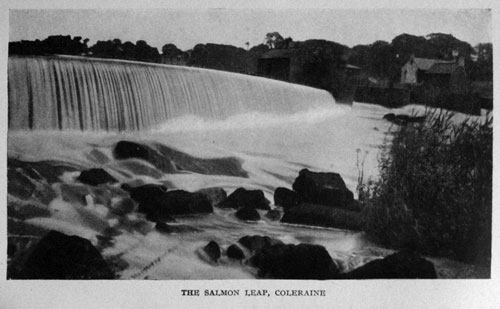
The visitor should pay a visit to St. Patrick's Church, which has choice stained glass and a beautiful reredos. Its communion chalice is a rare and exquisite vessel, the gift three hundred years ago of the Honourable the Irish Society of London, and in constant use ever since. The tower has beautiful stone work, and has a peal of eight bells.
Coleraine has a harbour, and connection with Liverpool, Glasgow, and the English and Scottish ports is regularly maintained.
Space does not permit any detailed reference to the history of the town. It has always been the spoiled child of London, "its beneficent mother," and under the aegis of the Honourable the Irish Society of London, has, since the Charter granted in 1612 by King James the First of England, had special favours in education, aids to buildings and to its institutions.
Dungiven
Also in the Valley of the River Roe, has both history and beauty to offer the tourist, few places in the North being richer in historical associations. It was a territory of the O'Cahans, and at the Abbey there is to be seen, perhaps, the most beautiful monument in Ulster, that of Cooey-na-gall, "Cooey of the Foreigners," who died in 1385. Banagher Old Church, founded by St. Muriedach O'Heney, still possesses his tomb, and whoever can secure a handful of sand from underneath it is assured of success in love, war, sport, or litigation. The district contains the birthplace of John Mitchel, whose "Jail Journal" is one of the classics of the English language.
Garvagh
Is a pretty little town four miles from the River Bann and nine from Coleraine. It is of historic importance, on account of it being the scene of one of the battles fought by Sir Phelim Roe O'Neill. Good fishing and shooting can be had in the neighbourhood.
Garvagh from the time of the Plantation was the Irish seat of the Canning family, of whom in the first quarter of the 19th century, George Canning was Foreign Secretary and Prime Minister. He was born in London, the son of George Canning, of Garvash, who, disinherited by hIs father, died of a broken heart, April 11th, 1771, the first anniversary of his famous son's birthday. Acute, expressive, witty, intensely British, he takes rank among England's foremost Ministers. He lives in history by one or two phrases -- "I called the New World into existence to redress the balance of the Old" -- and in verse by the "Needy Knife-grinder" -- "I give thee sixpence! I will see thee damned first." He was buried near Pitt in Westminster Abbey.
Kilrea
Is situated on the River Bann, where salmon and trout are plentiful. Portions of the river here are preserved, but licences can be got from Mr. James Gracey, Bridge Street, Kilrea.
Kilrea is well served by the railway and buses, and there is an excellent hotel in the town -- The Mercers' Arms, a favourite resort of anglers. A nine-hole golf course is an additional attraction.
Limavady
Is a town of considerable antiquity, and in the days of the Irish clans was the stronghold of the sept of the O'Cahans. It was twice destroyed -- in the wars of 1641 and of 1689. The neighbourhood has much of interest for the antiquary. Mullage, formerly called Drumceatt, was the seat of a Conference in 574 A.D., attended by St. Columba, which among other things gave the Irish colony in Scotland Home Rule. Then there are the "Leap" itself, the ruins of O'Cahan's Castle at Deerpark; "M'Quillan's Grave," the burial place of the unhappy Laura O'Donnell and her lover. Finn M'Quillan.
Limavady was the birthplace of a Premier of the Dominion of New Zealand the late Right Hon. W. F. Massey, P.C ., and though the house has been removed the site is in Kennaught Street. The school and church he attended are in lrishgreen street. The inn where Thackeray found inspiration for his ballad, "Peg of Limavady," still stands in Ballyclose Street. At present the old-established Alexander Arms provides accommodation for visitors.
There are local Tennis and Bowling Clubs, to which visitors are admitted by arrangement; and the Castlerock Golf Course is within convenient reach by both train and bus.
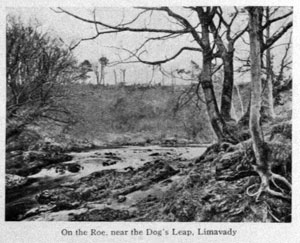
The River Roe flows through the centre of the rural district. Its principal tributaries are the Owenbeg and Owenreagh, which enter it near the town of Dungiven. There is very good trout fishing on each of these rivers, and the Roe has always been famed for salmon and sea trout fishing. The season opens on 1st April, and ends on 20th October. Licences for salmon-fishing -- £1 per annum -- can be had from the Secretary to the Conservators of Fisheries, Londonderry. These licences are, of course, applicable to all the rivers under the jurisdiction of the said Conservators.
There are two comfortable hotels in the town of Dungiven, and one in the town of Limavady.
Londonderry
Is the "maiden city" of the kingdom, it is one of the few walled cities in the British Isles, and these walls are intact and in a good state of preservation ; it is the only city in the kingdom which, preserving an intimate relationship extending over three centuries with London, can claim the capital of the Empire as a benevolent foster mother.
Londonderry is pleasantly situated on the bank of a noble river -- the Foyle -- about four miles from where the waters broaden out into a lough. The older parts of the city are built upon a hill rising to a height of about 120 feet above sea level, the top of which is crowned by an ancient Cathedral. In recent years the city has been greatly extended, especially towards the north end. The leading thoroughfare connecting the ancient and modern parts of the city, Shipquay Street, is among the steepest business streets in the kingdom.
The history of Londonderry can be traced back to the time of St. Columba, who, born not far from the neighbourhood, founded an abbey, or monastery, here in 546.
In 1609 the City of London was invited by King James I., to undertake the plantation of the North of Ireland. The King offered to make over to the City of London the city of Derry, the town of Coleraine and adjacent territory. In 1613 the Irish Society was founded by Royal Charter. It is part of, and yet distinct from, the Corporation of London, a sort of part within the whole which boasts of a separate existence. The court of the Honourable the Irish Society, as constituted by Charter, consists of a Governor, a Deputy-Governor, and twenty-four assistants. The Governor and five of the assistants are Aldermen of the City of London. The Recorder of London is also an assistant, and the Deputy-Governor and the remainder of the assistants are "commoners of the same city." Thus London became very largely responsible for the welfare of Derry the name of which was changed in 1613 to Londonderry. The walls, the building of which had been begun in 1600, took eighteen years to complete, the total cost being £9,000. They formed a circle round the CIty about a mIle in length and were from 20 to 24 feet high, with the breadth of a roadway. There were originally four gates.
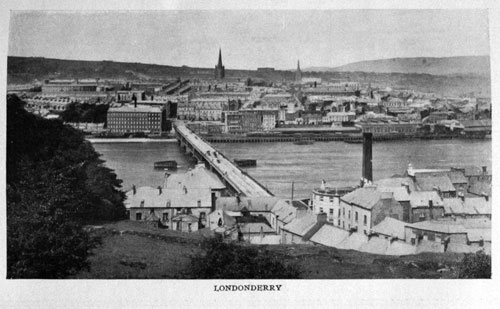
The Irish Society also rebuilt the Cathedral at a cost of £4,000 in 1633, and, indeed, as a tablet in the entrance porch of the edifice puts it "If stones could speak, then London's praise should sound who built this Church and city from the ground."
The Society have sold the greater part of their agricultural holdings, but they are still the head landlords of the city of Derry and borough of Coleraine. The deputation of the Society pays annual visits to Londonderry and Coleraine, and administers affairs, not as landlords seeking a profit out of the property, but rather as trustees for the inhabitants of both towns, to the development of which, the relief of taxation, and the aid of charitable and educational undertakings, they are bound to devote their income.
Londonderry in the seventeenth century successfully withstood three sieges, for which it gained the proud title of "the maiden city."
On the walls to-day can be seen some of the old cannons used in the siege, amongst them the famous "Roaring Meg," which throughout thundered defiance at the enemy. In the Cathedral are the poles and tassels of flags captured from the French force which had assisted in besieging the city. The white silk of the flags was renewed in 1788 and again in 1888. The Episcopate, one of the most remarkable figures in Irish history -- Lord Bristol -- was in connection with this Cathedral.
The heroism displayed by the citizens has given Londonderry an abiding place in history, and the closing of the gates in December, and the relief of the city in August, are still commemorated by public demonstrations.
The chief industry is the manufacture of shirts, collars and underclothing, of which the city is the recognised centre. There are about sixteen large factories, and over a score of smaller concerns. In recent years a kindred industry, that of hosiery and knitted goods, has been established on a successful basis. There are also several extensive ham and bacon-curing factories, flour and meal mills, brass and iron foundries, boxmaking factories, mineral water factories and distilleries.
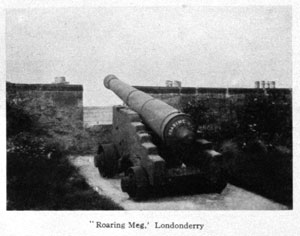
Londonderry is the second port of importance in the North of Ireland.
The Burns-Laird Line maintains a regular service to and from Glasgow, and a bi-weekly service to and from Heysham. The vessels engaged on these services are comfortable and well-appointed. There is also a regular service to and from Liverpool.
Londonderry is the Irish port of call for the vessels of the Anchor Line plying between Glasgow and New York, and the Anchor-Donaldson Line between Glasgow and Canadian ports. The liners, incoming and outgoing, arrive in Lough Foyle, during the week-end and lie off Moville, the passengers making the journey between the quays and the liner by tender in a little over an hour's time.
Londonderry has many fine schools, including Foyle College. It was here that the two great Lawrences, whose names will ever be associated with India, were educated.

Good shooting may be had in the immediate neighbourhood, and a little further afield on the mountains and moors of the Counties of Derry, Donegal and Tyrone. which are well stocked with birds and ground game. For anglers, the River Faughan, which passes within three miles of the city, carries in the summer and autumn months good runs of salmon and sea trout and small brown trout. The Mourne and the Finn, tributaries of the Foyle, within fifteen to twenty miles from Londonderry, also provide capital salmon and trout fishing. The Newtownstewart district also on the Mourne -- where there is a salmon hatchery -- is a favoured resort of anglers.
Golfers are provided with facilities for the game at Prehen, within two miles of Londonderry, the links of the City of Derry Golfing Club, and at Lisfannon, on the shores of Lough Swilly, the headquarters of the North-west Golf Club. The links at Castlerock and Portrush, upon which Irish Championships have been decided, are within an hour and a half's journey by rail from Londonderry .
The Foyle has a long and proud record in Irish rowing. The City of Derry Boating Club is invariably represented at the leading Irish regattas, and the crews have long lists of successes to their credit.
Close to Derry lie the villages of Claudy, Eglinton and Faughan, where lodgings can be obtained in farm houses, and good fishIng in the neighbourhood.
Further information regarding Hotels and Boarding-houses may be obtained from the Town Clerk, Londonderry.
Magherafelt and Maghera
Near the towns of Magherafelt ("the Plain of the Rushes") and Maghera lie some very pretty villages, viz., Bellaghy, Draperstown, Desertmartin, lnnisnesh, Knockloughrim, Moneymore, Tobermore and Swatragh, and the principal river In the district, which can be easily reached from any of these towns or villages, is the Moyola; salmon fishing rights are reserved, but licences can be obtained from the Eel Fishery, Toomebridge, Co. Antrim. There are two comfortable hotels In Magherafelt, two in Maghera, one in Draperstown, one in Moneymore, one in Tobermore, and one in Swatragh, and splendid rail and bus services connect all the towns in the district.
Glenshane Pass between Maghera and Dungiven, Carndaisy Glen and Lough Fea, near Moneymore, the Windy Gap, Slievegallion, near Desertmartin, and Carntogher Hills, near Maghera, provide scenery beautiful in the extreme, while the antiquary can loiter in the old churches at Maghera, Ballinascreen or Church Island in Lough Beg. The whole region is rich in legend, Lough Bran, for instance, being named after Finn's dog, which scratched the hole in pursuit of its quarry, a magic deer, the hole filling with water and hence the lake.
There are nine-hole golf courses at Mashera and Magherafelt, and Tennis Clubs at Magherafelt, Maghera, Moneymore, and Draperstown.
Castledawson, in this neighbourhood, supplied a family distinguished in naval history, no fewer than four sons of the Rev. Thomas Graves rising to Admiral's rank.
Portstewart
Popularly known as the "Health Mecca," lies in a sheltered situation facing west, and over-looking one of the most beautiful bays in Northern Ireland. Protected from the bitter east winds, the air here is delightfully cool and soft. WIth Just enough crispness to produce a delightful sense of exhilaration. The town is semi-circular in shape, and has at one end the Harbour, and at the other the gaunt Castle of O'Hara. Beyond the Castle there are some fine cliffs dipping down to a magnificent Strand, which stretches for about two miles to the entrance of the River Bann.
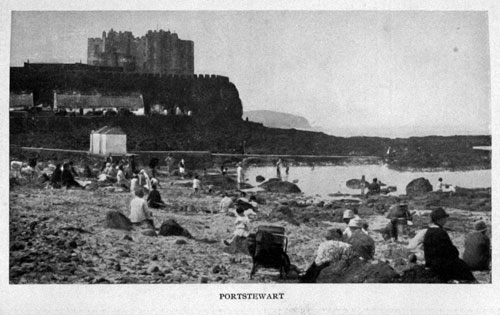
From an historical point of view the town claims notice from the traveller and tourist. Here Doctor Clarke, the famous Commentator, was born and lived; here Charles Lever, while dispensary doctor, wrote one of his famous novels; and here at Rock Castle was born the defender of Ladysmith, Sir George White, V.C.
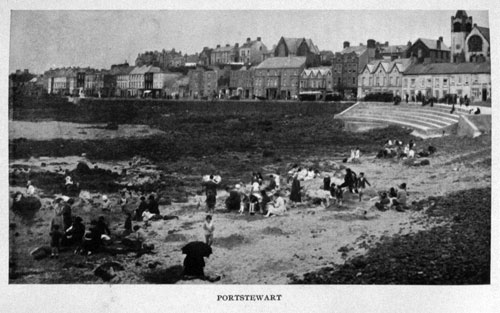
Portstewart boasts two excellent golf courses -- one 12 and the other 18 holes. The former is along the seaboard and the latter skirts the sand dunes and River Bann.
Boarding-houses and hotels are plentiful, and their charges moderate. (A list of these together with copy of town guide can be had on application to the Town Clerk).
Boating and Fishing -- These recreations can be indulged to the heart's content, whether on the bay or river. The Bann is famous for its trout. Local excursions form a pleasant variety during a sojourn at the seaside, and nowhere can be found a finer fleet of motor coaches plying itineraries to the several surrounding places of interest, notably -- the Giant's Causeway, the Glens of Antrim, and the Salmon Leap.
Bathing facilities are abundant. The morning plunge in the "Herring Pond," or "Port-na-haple," exhilarates to a marvellous degree, and no better specific to brace the system for toil or pleasure can be imagined. Mixed bathing is permitted. The Crescent offers facilities for non-swimmers and beginners.
Co. Tyrone
Cookstown
A flourishing market and manufacturing town at the termini of the Great Northern and Midland Railways. In the town and surrounding districts are linen and tape factories, spinning and flax scutching mills, and Co-operative creameries.
Cookstown has the distinction of being the headquarters of one of the oldest golf clubs in Ireland -- the Killymoon. This is a nine-hole course of inland type, and is the home course of Miss Rhona Adair, who won the Ladies' Championship on two occasions, and the Irish Ladies' Cup no fewer than four times in succession. There are several good hotels. The River Ballinderry is stocked with big lake trout and occasional salmon.
About ten miles from Cookstown, on the western shores of Lough Neagh, stands the high stone cross of Arboe, one of the finest specimens of its kind in Ireland. The cross is 181/2 feet high and the arms 31/2 feet wide. The panels on the cross depict various Biblical scenes, such as Adam and Eve in the Garden of Eden, the Ark, Daniel in the Lion's Den, etc.
Possibly Cookstown's most famous natives are the brothers Charles, of whom Major-General Sir Richard Havelock Charles, G.C.V.O., is a distinguished member of the Indian Medical Service, and Serjeant-Surgeon to His Majesty King George V. His brother, Ven. R Henry Charles is Archdeacon of Westminster, and a notable' authority in ecclesiastical history.
William Erigena Robinson has become widely known in the United States as journalist and poet.
Mr. William Graham Browne, husband of Miss Marie Tempest, is himself a well-known actor and producer.
Dungannon
Is very rich in historic interest. It was the principal seat of the O'Neill's, Kings of Ulster, till 1607, when the last of those sovereigns was forced to flee from the country.
Of the Royal Residence and Castle of the O'Neill's which was situated on the summit of the hill, no traces remain save the crumbling walls of the family chapel and a few subterranean passages which have never been properly explored.
There are several trout streams in the neighbourhood, particularly the Torrent, the Oona and the Rhone Rivers, and excellent sport is obtained.
There are also tennis clubs, hockey clubs, and golf links, to which visitors are welcomed.
The village of Arboe, 12 miles from Dungannon, contains one of the finest and best preserved specimens of the Old Irish Cross -- one of the five crosses erected throughout Ireland in memory of St. Colman. In the old-world village of Cappagh, near by, copper mines were worked. and five miles from Dungannon, in the little village of Benburb, stands the old ruined Castle, which was once the seat of the O'Neill's.
The little village of Donaghmore, situated two miles from Dungannon, has a history which goes far into the remote past. Here St. Patrick founded an Abbey in which he placed St. Columb. Within its precincts was a large and elegant cross of freestone, on which were inscribed numerous hieroglyphics representing various passages in the Scriptures. It consists of a plinth, a shaft, and a cross, and is sixteen feet in height. In 1776 it was removed and placed where it now stands at the head of the VIllage. George Walker, the defender of Derry, was rector of Donaghmore. In the same parish is the ancient village of Castlecaulfield, which contains the remains of an old Castle erected in 1614 by Sir Toby Caulfeild, the ancestor of the Charlemont family.
The Rev. Charles Wolffe, who wrote the well-known ode on the Burial of Sir John Moore, was curate of the parish from 1818 till 1823.
The little town of Moy, four miles from Dungannon, has a somewhat continental appearance, owing to rows of trees planted on either side of the Square, which is its principal street. It was built by Francis William, Earl of Charlemont. after the style of Marengo, an Italian town which he had visited and much admired.
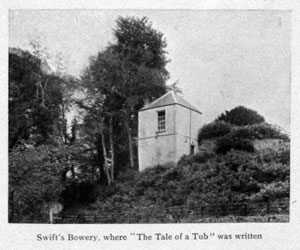
Situated about eight miles from Dungannon is Tullyhogue, which was a place of great importance in early days. On a hill outside the village is a large circular encampment, surrounded by earthworks, where formerly stood the residence of the O'Hagans, which contained a chair of stone in which the Kings of Ulster were solemnly inaugurated under the title of "The O'Neill." Near Tullyhogue is Loughrey, the residence of the Lyndsays since the reign of James I. In the grounds are to be seen the home and cottage of the celebrated Dean Swift.
Three distinguished judges have sprung from this neighbourhood -- Baron Dowse, Sir Joseph Frizelle, and Lord Justice Holmes.
Further information regarding Hotels and Boarding-houses may be obtained from the Town Clerk, Dungannon .
Newtownstewart
A pretty little town, three miles distant from Baronscourt, the magnificent ancestral home of His Grace the Governor of Northern Ireland -- the Duke of Abercorn, K.P. The Foyle and Bann Fishery Company have a salmon hatchery near the town, and a new golf links has recently been opened.
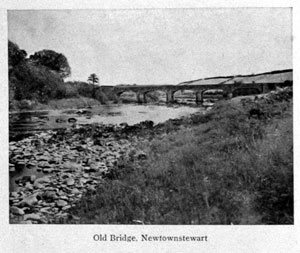
The Mourne is formed by the junction of the Strule and the Glenelly rivers at Newtownstewart. The Strule is the better river of the two as regards trout, and has a local Club at Omagh. Its head-waters are good for nice brown trout of 1/2 to 3/4-lb. weight. Lower down trout of 2 and 21/2-lbs. have been taken on salmon flies. The bulk of the salmon and nearly all the sea-trout are killed below Newtownstewart; while the other river -- the Glenelly -- gets more than its share of both salmon and white trout.
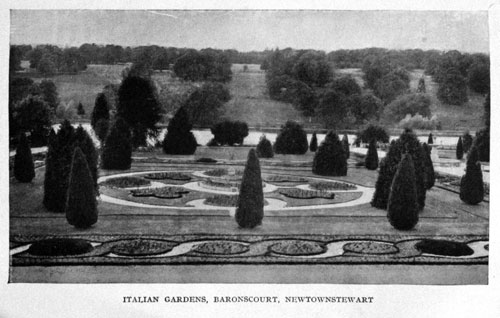
Newtownstewart claims as a native, Sir Thomas Maclear, F.R.S. (1794-1879), Astronomer-royal at the Cape of Good Hope; Rev. Dean O'Kane, who was a Roman Catholic divine and scholar; and Rev. R. R. Kane, who was a famous Protestant divine and politician, while the ancestral home of the Armours, the founders of the great meat-packing firm, is at Drumquin, close to the town.
Omagh
The capital and assize town of County Tyrone, is delightfully situated amidst some of the most charming scenery in the North of Ireland.
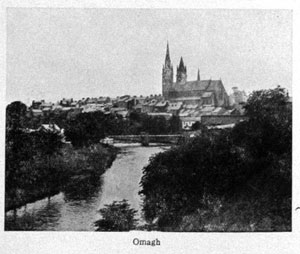
The monument erected to the memory of the officers and men of the Royal Inniskilling Fusiliers who fell in the South African War, 1899-1902, occupies a commanding position in High Street; whIle the County Tyrone War Memorial, erected to the memory of the officers and men from the County who fell in the Great War, 1914-1918 occupies a striking situation on the Mountjoy Road at the approach to the town from Derry. Both speak eloquently of Omagh's proud military history, and of its close assocIation with the 1st Royal Inniskilling Fusiliers, the Depot of whIch is in the town.
The present Ulster Bank premises stand on the site formerly occupied by the house in which King James II. stopped while on his flight from Derry after the historic siege. Another reminder of those times is to be found in the Oldbridge at Irishtown, which spans the River Drumragh near the town, and over which King James passed after giving orders for the burning of the town.
The Rivers Strule and Drumragh, and their tributaries (Camowen, Fair Water and smaller streams) are noted for their excellent salmon and trout fishing, while the Strule has also secured a large measure of fame for its pearls. There is also some lake fishing to be had in the vicinity.
The Lover's Retreat, an exceptionally picturesque spot on the outskirts of the town, has been acquired as a public park and children's playground. It is a valuable acquisition to the town, and a pleasant ramble for tourists, overtopped by mountains, including the well-known Bessy Bel and Mary Gray. Gortin Gap, with its fine range of hills on each side, is well worth of a visit, as also Curraghchosaly, The Robbers' Table, Beauty Hill, range after range of hills, extending on into Co. Derry, where cheap shooting is obtainable, and where with a very moderate expenditure a veritable paradise of sport can be secured.
Omagh is specially favoured in its railway and bus services being situated at the Junction of the Belfast, Londonderry and Enniskillen lines, regular and frequent services, both by bus and raIl, being maintained.
There is a local Hunt Club, and the golf course is one of the best. Lawn tennis and badminton clubs are plentiful, and visitors are allowed to participate on easy terms in all forms of sport.
Close to Omagh are the villages of Fintona, where there is a picturesque 9-hole golf course, and the ancient town of Gortin, rich in archaeological ruins.
Strabane
Is an enterprising market town in Country Tyrone, about twelve miles from Derry, beautifully situated on the river Mourne, amid scenery which can vie with any in the kingdom.
As a flax, pork, butter, grain and grass seed market, Strabane is surpassed by few towns in the North- West of Ireland.
The town is in the centre of a very large industrial district, in which shirtmaking, collarmaking, spinning and milling are carried on. It has direct railway communication with Derry, Belfast and Dublin, and forms the junction of a narrow-gauge railway running from Londonderry to Killybegs and Ballyshannon, through the valley of the Finn, with a branch line from Stranorlar to Glenties, one from Strabane to Letterkenny via Raphoe to Convoy, and another to Londonderry via Dunnamannagh. There is also communication for goods to Derry via the Strabane Canal.
There is an excellent 9-hole links at Carricklee, within one mile from Strabane. Open to visitors, 2/6 per day. Sunday golf.
There are also excellent Tennis Courts, open to visitors, 2/6 per week.
The River Mourne, on which Strabane is situated, is one of the best salmon and trout rivers in the North of Ireland.

Two natives of Strabane rose to eminence in the New World --
Guy Carleton, later the first Baron Dorchester, was born in Strabane on the 3rd September, 1724. Entering the army, he was Wolfe's right-hand man and staunch supporter at the siege of Quebec, where he was wounded and promoted to the rank of Brigadier-General. He later became Governor-General of Canada, and on the outbreak of the American Revolution he defended Quebec, and defeated the American Army under Montgomery (a native of Donegal and an old brother officer). In 1786, Carleton was again Governor-General. Many important reforms marked his rule, and by his justice and kindliness, tact, and moderation, he kept the country loyal to the British Crown. He died on the 10th November, 1808. In Carleton and the late Marquis of Dufferin, Ulster supplied the two greatest statesmen who ever swayed the destinies of Canada.
John Dunlap, American revolutionary patriot, was born in Strabane about 1746. At an early age he went to Philadelphia, where his Uncle William was a printer and publisher. Getting sole charge of the business, he established the "Pennsylvania Packet," which in 1784 became a daily paper, the first in the United States. As printer to Congress, Dunlap printed the first copies of the Declaration of Independence.
President Woodrow Wilson's grandfather, James Wilson, belonged to Dergalt, two miles east of Strabane, and worked in a printer's shop -- Messrs. Gray's, in the main street of that town -- prior to emigrating.
Nor should it be forgotten that Doctor George Sigerson, scholar, poet, scientist, and publicist, was a native of Strabane.
Hotels in Northern Ireland
Recommended by Belfast and North of Ireland Hotel Association.
ANTRIM. |
|
| ANTRIM ARMS HOTEL-- | |
| Bed and Breakfast from 7/6. | Daily rate from 12/6. |
| MASSEREENE ARMS HOTEL-- | |
| Bed and Breakfast from 7/6. | Daily rate from 12/6- |
ARMAGH. |
|
| CHARLEMONT ARMS HOTEL-- | |
| Bed and Breakfast from 7/6. | Daily rate from 12/-. |
BELFAST. |
|
| MIDLAND STATION HOTEL-- | |
| Bed and Breakfast from 11/6. | |
| GRAND CENTRAL HOTEL-- | |
| Bed and Breakfast from 9/6. | |
| ROYAL AVENUE HOTEL-- | |
| Bed and Breakfast from 9/6. | |
| IMPERIAL HOTEL-- | |
| Bed and Breakfast from 9/6. | Daily rate from 18/-. |
| KENSINGTON HOTEL-- | |
| Bed and Breakfast from 8/6. | Daily rate from 15/-. |
| UNION HOTEL-- | |
| Bed and Breakfast from 8/6. | Daily rate from 15/-. |
| QUEEN'S HOTEL-- | |
| Bed and Breakfast from 8/6. | Daily rate from 15/-, |
| EGLINTON AND WINTON HOTEL-- | |
| Bed and Breakfast from 8/6. | Daily rate from 15/- |
| ALBERT HOTEL-- | |
| Bed and Breakfast from 8/-. | Daily rate from 14/-. |
| GRANVILLE TEMPERANCE HOTEL-- | |
| Bed and Breakfast from 7/6. | Daily rate from 12/6. |
| ROBINSON'S TEMPERANCE HOTEL-- | |
| Bed and Breakfast from 7/6. | Daily rate from 13/6. |
BANGOR. |
|
| ROYAL HOTEL-- | |
| Bed and Breakfast from 8/6. | Daily rate from 14/-. |
| IMPERIAL HOTEL-- | |
| Bed and Breakfast from 7/6. | Daily rate from 13/-. |
BALLINTOY. |
|
| CARRICK-A-REDE HOTEL-- | |
| Bed and Breakfast from 6/. | Daily rate from 10/-. |
BALLYCASTLE. |
|
| MARINE HOTEL-- | |
| Bed and Breakfast from 9/6. | Daily rate from 16/6. |
CUSHENDALL. |
|
| GLENS OF ANTRIM HOTEL-- | |
| Bed and Breakfast from 9/-. | Daily rate from 15/-. |
| DELARGY'S HOTEL-- | |
| Bed and Breakfast from 7/6. | Daily rate from 12/6. |
| GLENVILLE HOTEL-- | |
| Bed and Breakfast from 6/6. | Daily rate from 15/-. |
CUSHENDUN. |
|
| CUSHENDUN HOTEL-- | |
| Bed and Breakfast from 6/-. | Daily rate from 10/-. |
CARNLOUGH. |
|
| LONDONDERRY ARMS HOTEL-- | |
| Bed and Breakfast from 6/6. | Daily rate from 10/-. |
DONAGHADEE. |
|
| MOUNT ROYAL HOTEL-- | |
| Bed and Breakfast from 8/6. | Daily rate from 15/-, |
| IMPERIAL HOTEL-- | |
| Bed and Breakfast from 7/-. | Daily rate from-- Summer, 14/-; Winter, 12/-. |
ENNISKILLEN. |
|
| LOUGH ERNE HOTEL-- | |
| Bed and Breakfast from 10/-. | Daily rate from 15/-. |
| IMPERIAL HOTEL-- | |
| Bed and Breakfast from 8/-. | Daily rate from 14/-. |
| ROYAL HOTEL-- | |
| Bed and Breakfast from 8/6. | Daily rate from 14/-. |
GARRON POINT (Antrim Coast). |
|
| GARRON TOWER HOTEL-- | |
| Bed and Breakfast from 7/6. | Daily rate from 12/6. |
GLENARM. |
|
| ANTRIM ARMS HOTEL-- | |
| Bed and Breakfast from 5/6. | Daily rate from 11/-. |
GIANT'S CAUSEWAY. |
|
| ROYAL HOTEL-- | |
| Bed and Breakfast from 7/6. | Daily rate from 12/-. |
| CAUSEWAY HOTEL-- | |
| Bed and Breakfast from 9/-. | Daily rate from 15/-. |
KILKEEL. |
|
| KILMOREY ARMS HOTEL-- | |
| Bed and Breakfast from | Daily rate from |
KILREA. |
|
| MERCER'S ARMS HOTEL-- | |
| Bed and Breakfast from 7/6. | Daily rate from 13/6. |
LARNE. |
|
| OLDERFLEET HOTEL-- | |
| Bed and Breakfast from 10/6. | Daily rate from 18/-. |
| KING'S ARMS HOTEL-- | |
| Bed and Breakfast from 7/6. | Daily rate from 12/6. |
| LAHARNA HOTEL-- | |
| Bed and Breakfast from 7/6. | Daily rate from 12/6. |
LIMAVADY. |
|
| ALEXANDER ARMS HOTEL-- | |
| Bed and Breakfast from 6/6. | Daily rate from 12/-. |
LONDONDERRY. |
|
| CITY HOTEL-- | |
| Bed and Breakfast from 8/-. | Daily rate from 14/-. |
| MELVILLE HOTEL-- | |
| Bed and Breakfast from 8/-. | Daily rate from 16/-. |
| METROPOLE HOTEL-- | |
| Bed and Breakfast from 7/-. | Daily rate from 14/-. |
| NORTHERN COUNTIES HOTEL-- | |
| Bed and Breakfast from 8/-. | Daily rate from 15/-. |
LURGAN. |
|
| BROWNLOW ARMS HOTEL-- | |
| Bed and Breakfast from 6/6. | Daily rate from 10/6. |
MAGHERA. |
|
| McNICHOLL'S HOTEL-- | |
| Bed and Breakfast from 6/-. | Daily rate from 10/-. |
| WALSH'S HOTEL-- | |
| Bed and Breakfast from 6/-. | Daily rate from 10/-. |
NEWCASTLE. |
|
| SLIEVE DONARD HOTEL-- | |
| Bed and Breakfast from 10/6. | Daily rate from 15/-. |
| DONARD BUILDINGS HOTEL-- | |
| Bed and Breakfast from --/-. | Daily rate from --/-. |
NEWRY. |
|
| VICTORIA HOTEL-- | |
| Bed and Breakfast from 7/-. | Daily rate from 12/-. |
| IMPERIAL HOTEL-- | |
| Bed and Breakfast from 7/6. | Daily rate from 12/-. |
PORTADOWN. |
|
| IMPERIAL HOTEL-- | |
| Bed and Breakfast from 7/6. | Daily rate from 12/6. |
| QUEEN'S HOTEL-- | |
| Bed and Breakfast from 7/6. | Daily rate from 11/6. |
PORTRUSH. |
|
| NORTHERN COUNTIES HOTEL-- | |
| Bed and Breakfast from 11/6. | Daily rate from 15/-. |
| PORTRUSH HOTEL-- | |
| Bed and Breakfast from 7/6. | Daily rate from 12/6. |
ROSTREVOR. |
|
| GREAT NORTHERN HOTEL-- | |
| Bed and Breakfast from 8/6. | Daily rate from 15/-. |
WARRENPOINT. |
|
| LIVERPOOL HOTEL-- | |
| Bed and Breakfast from 6/6. | Daily rate from 10/-. |
WHITEHEAD. |
|
| WHITEHEAD HOTEL-- | |
| Bed and Breakfast from 7/-. | Daily rate from 12/-. |
GENERAL INFORMATION.
Where Daily Rate is quoted, same is offered for a stay of not less than one week.
Meals served in Bed or Sitting Rooms are subject to 25 per cent. increase.
Intending visitors are advised to give earliest possible notice to Hotel they intend to patronise.
Alphabetical List of Golf Clubs
WITH THEIR HON. SECRETARIES, NUMBER OF HOLES, STANDARD SCRATCH SCORES.
Information regarding Green Fees, etc., can be had from the various Secretaries, and also from the Offices of the Ulster Tourist Development Association, Ltd.
*Denotes Sunday play permitted.
BELFAST. | Holes. | Std. Sch. Scores. |
| * BALMORAL-- | ||
| Sec. -- Capt. T. S. Forster, c/o. Golf Club. | ||
| Hon. Sec. -- R. W. Stuart, 3 Central Av., Marlborough Park | 18 | 74 |
| BELVOIR PARK-- | ||
| Joint Hon. Secs.-- | ||
| R. Stanley Drean, A.C.A., 1 Lombard St. | ||
| J. K. Christie, Gleneagles, Knockbreda Park | 18 | 76 |
| CLIFTONVILLE-- | ||
| H. McMillan, A.S.A.A., 44 Donegall St. | 18 | 76 |
| *FORTWILLIAM | ||
| James Campbell, 36 Hopefield Avenue | 18 | 75 |
| *KNOCK-- | ||
| John W. Knox, Summerfield, Dundonald | 18 | 75 |
| *MALONE-- | ||
| C. S. Harden, c/o. Golf Club | 18 | 75 |
| ORMEAU-- | ||
| J. K. Christie, c/o. Golf Club | 9 | 71 |
| SHANDON PARK-- | ||
| S. Nevin, Kingsden Park, Knock | 9 | 70 |
CO. ANTRIM |
||
| *BALLYCASTLE-- | ||
| Wm. H. Relford, Fleurville, Ballycastle | 18 | 74 |
| BALLYCLARE-- | ||
| J. Hadden, Coolen, Ballyclare | 9 | 65 |
| BALLYMENA-- | ||
| J. N. Lamont, Edenagrena, Ballymena | 9 | 72 |
| BUSHFOOT, near Bushmills-- | ||
| Joseph Black, Portballintrae, Bushmills | 9 | 61 |
| CARRICKFERGUS-- | ||
| David Law, Hopefield, Carrickfergus | 9 | 67 |
| CULLYBACKEY-- | ||
| W. J. Kernohan, Spring Hill, Cullybackey | 9 | 69 |
| DUNMURRY-- | ||
| Hugh Stevenson, 13 Donegall Sq. N., Belfast | 9 | 75 |
| GREENISLAND-- | ||
| Matthew Anderson, Breezemount, Tropper's Lane | 9 | 72 |
| LARNE, Islandmagee-- | ||
| T. A. Purdon, The Mount, Larne Harbour | 9 | 75 |
| LISBURN-- | ||
| The Secretary, c/o. Golf Club Longstone, Lisburn | 9 | 73 |
| MASSEREENE, Antrim-- | ||
| Hamilton Millar, Fountainville, Antrim | 9 | 72 |
| *PORTRUSH ROYAL-- | ||
| F. R. St. Lawrence Tyrrell, Club House, Portrush | 18 | 76 Gent's. |
| 9 | - Ladies. | |
| SHANE'S PARK, Randalstown-- | ||
| Fred W. Rs, Northern Bank, Randalstown | 9 | 64 |
| WHITEHEAD-- | ||
| R. S. Adamson, Rathmoyle, Whitehead | 9 | 74 |
CO. ARMAGH. |
||
| ARMAGH-- | ||
| W. S. Moore, Drumad Cottage, Armagh | 9 | 72 |
| BESSBROOK-- | ||
| J. A. Downey, Woodville, Bessbrook | 9 | 64 |
| LURGAN-- | ||
| H. C. Malcolm, Bengal Place, Lurgan | 9 | 76 |
| PORTADOWN-- | ||
| Alfred Lynas, Ardbree, Portadown | 9 | 72 |
| TANDERAGEE-- | ||
| Edmund A. Smith, Ivy Bank, Tanderagee | 9 | 71 |
CO. DOWN. |
||
| ARDGLASS-- | ||
| Joint Hon. Secs.- | ||
| Jas. Z. Sloan, The Terrace, Downpatrick | ||
| Jas. McMechan, Belfast Bank, Downpatrick | 9 | 68 |
| BANBRIDGE-- | ||
| H. Kelso, Hazelbrook, Laurencetown | 9 | 74 |
| BANGOR MUNICIPAL, Carnalea-- | ||
| Sports Organiser, Town Hall, Bangor | 18 | 74 Gent's. |
| 75 Ladies. | ||
| *BANGOR-- | ||
| J. A. Hurst, Golf Club, Bangor | 18 | 74 |
| *BELFAST ROYAL, Craigavad-- | ||
| Major J. C. Trout, O.B.E., c/o. Golf Club, Craigavad | 18 | 75 |
| *CUAN-- | ||
| G. H. Wallis, Strangford, Co. Down | 9 | 66 |
| *DONAGHADEE-- | ||
| W. B. Fennell, Donaghadee | 18 | 68 |
| *DOWN ROYAL, County, Newcastle-- | ||
| Fred H. Rogers, c/o. Golf Club, Newcastle | 18 | 77 |
| HELEN'S BAY, Co. Down-- | ||
| J. L. Bennet, Helen's Bay | 9 | 69 |
| *HOLYWOOD-- | ||
| W. T. Cochran, lnversnaid, Holywood | 18 | 70 |
| KIRKISTOWN CASTLE-- | ||
| Rev. S. Stephenson, and Rev. M. G. Gardiner, Kirkcubbin | 9 | 75 |
| More text still to add... ... ... ... |
Acknowledgments
The Ulster Tourist Development Association, Ltd., acknowledges with grateful thanks the kindness of Mr. W. A. Green, Mr. R. J. Welch, M.Sc., Mr. J. R. Bainbridge, M.Sc., Mr. A. Lee, in permitting the use of photographs supplied by them for this Guide. It would also acknowledge the kindness and courtesy of Urban and Rural District Councils and their respective Clerks throughout the Province, who rendered the Association every assistance in procuring authentic material and in supplying photographs; also "Belfast News-Letter," Ltd., for copyright blocks of Motor Car Race.
The Association's thanks are also due, in a large measure, to Mr. St. John Ervine, who by his brilliant pen, has kept Ulster prominently before the public, and from whose book "Ulster" prolific extracts have been taken for this work. (The extracts are as far as possible denoted by inverted commas.)
Finally, the Association would like to express to Mr. Alexander Riddell, who edited this Guide, its gratitude for the painstaking care and thoroughness with which his work has been done.

